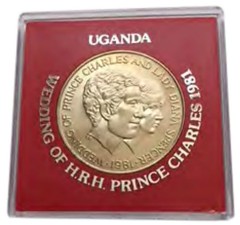
About UsThe Numismatic Bibliomania Society is a non-profit association devoted to the study and enjoyment of numismatic literature. For more information please see our web site at coinbooks.org SubscriptionsThose wishing to become new E-Sylum subscribers (or wishing to Unsubscribe) can go to the following web page link MembershipThere is a membership application available on the web site Membership Application To join, print the application and return it with your check to the address printed on the application. Print/Digital membership is $40 to addresses in the U.S., and $60 elsewhere. A digital-only membership is available for $25. For those without web access, write to: Terry White, Treasurer AsylumFor Asylum mailing address changes and other membership questions, contact Terry at this email address: terrywhite5475@yahoo.com SubmissionsTo submit items for publication in The E-Sylum, write to the Editor at this address: whomren@gmail.com
BUY THE BOOK BEFORE THE COIN |
- WAYNE'S WORDS: THE E-SYLUM FEBRUARY 10, 2019
- KOLBE &FANNING BUY OR BID SALE NUMBER 9
- NEW BOOK: CANADIAN BANK NOTES 9TH EDITION
- THE 1991 EAC MIDNIGHT SALE
- MORE ON DONALD J. LUTES JR.
- MORE ON JAMES C. RISK
- NOTES FROM E-SYLUM READERS: FEBRUARY 10, 2019
- MORE ON THE PACIFIC COAST EXPOS BOOK MEDAL
- GARY BEALS: ZINC, YOU STILL STINK!
- A 1924 IMMIGRANT'S PAPER MONEY
- VOCABULARY TERM: CHASING
- JOSEPH FRANCIS NEGREEN, JR. (1881-1924)
- HARVEY STACK'S NUMISMATIC FAMILY, PART 37
- JOSEPH MENNA APPOINTED TO CHIEF ENGRAVER
- DR. DEAN J. KOTLOWSKI APPOINTED TO CCAC
- MARCH 2019 ANA MONEY TALKS
- INTERNATIONAL PAPER MONEY SPEAKERS SOUGHT
- NEWMAN GRADUATE SEMINAR IN NUMISMATICS
- ANCIENT GREEK AND ROMAN NUMISMATICS SCHOOL
- NUMISMATIC NUGGETS: FEBRUARY 10, 2019
- STACK'S BOWERS 2019 BALTIMORE EXONUMIA SELECTIONS
- 1855 WASS, MOLITOR &CO. $50 PRIVATE GOLD
- 1838 PROPOSED NATIONAL CURRENCY NOTE
- REPLICAS OF WORLD'S LARGEST COIN OFFERED
- SAGE'S CANDY COIN COUNTERSTAMP
- GERMAN NOTGELD
- HONG KONG BANKNOTE DESIGNS
- PAPER BIKINIS SUPPLANTING HELL MONEY?
- LOOSE CHANGE: FEBRUARY 10, 2019
- FEATURED WEB PAGE: CHARLETON PRESS
Click here to access the complete archive a
Click here to unsubscribe (scroll down)
To comment or submit articles, reply to whomren@gmail.com
Content presented in The E-Sylum is not necessarily researched or independently fact-checked, and views expressed do not necessarily represent those of the Numismatic Bibliomania Society.
WAYNE'S WORDS: THE E-SYLUM FEBRUARY 10, 2019
 We have no new subscribers this week.
We currently have 5,814 subscribers.
We have no new subscribers this week.
We currently have 5,814 subscribers.
Thank you for reading The E-Sylum. If you enjoy it, please send me the email addresses of friends you think may enjoy it as well and I'll send them a subscription (but let me know if they are located in the European Union). Contact me at whomren@gmail.com anytime regarding your subscription, or questions, comments or suggestions about our content.
This week we open with a new Kolbe & Fanning numismatic literature Bid or Buy sale, one new book, the 1991 EAC Midnight Sale, and more information on 1943 bronze cent discoverer Don Lutes, Jr.
Other topics this week include James Risk, zinc coinage, the new Chief Engraver of the U.S. Mint, a new appointee to the Citizen's Coinage Advisory Committee (CCAC), and Money Talks speakers at the March ANA National Money Show.
To learn more about Canadian Bank Notes, the Goodspeeds Lesher Dollar, Queen Anne, German inflation and emergency money, dealer Joseph Negreen, the Hopi Prayer for Rain medal, the 119th United States Colored Infantry, Mendenhall's National Currency plan, Sage's Candy Coin counterstamp, German notgeld, and the world's largest coin, read on. Have a great week, everyone!
Wayne Homren
Editor, The E-Sylum
KOLBE &FANNING BUY OR BID SALE NUMBER 9
Numismatic Booksellers Kolbe & Fanning submitted this announcement of their eighth "Buy or Bid Sale" which closes on February 22, 2019. Good luck, everyone! -Editor
 Kolbe & Fanning Numismatic Booksellers have announced our ninth "Buy or Bid Sale," which begins now and will close on February 22, 2019. The sale focuses on modestly priced books, giving collectors an opportunity to add to their libraries at minimal cost.
Kolbe & Fanning Numismatic Booksellers have announced our ninth "Buy or Bid Sale," which begins now and will close on February 22, 2019. The sale focuses on modestly priced books, giving collectors an opportunity to add to their libraries at minimal cost.
There is no printed catalogue. The PDF catalogue is available now for downloading from the Kolbe &Fanning website at numislit.com .
As the name of the sale suggests, customers may bid on items they wish to acquire or buy them outright at the published price. The Terms of Sale will give full instructions on how to participate: please read it carefully.
The sale includes over 1500 works on ancient, medieval and modern coins, as well as general works, periodicals and sale catalogues. "Buy" prices have been kept low to promote sales. To further encourage participation, the firm is offering free domestic shipping to bidders spending at least $300; there is also no packing and processing fee for this sale. Again, please read the Terms of Sale before participating.
Please send all bids to orders@numislit.com or use the bid sheet included at the end of the PDF catalogue.
THE BOOK BAZARRE
NEW BOOK: CANADIAN BANK NOTES 9TH EDITION
A new edition of Charlton's Canadian Bank Notes book has been published. Here's the information from the publisher's web site. -Editor
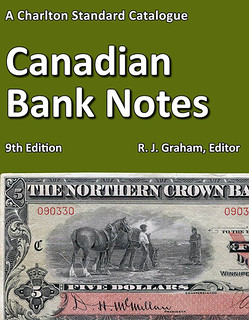 2019 Charlton Canadian Bank Notes 9th Edition
2019 Charlton Canadian Bank Notes 9th Edition
Editor: R.J. Graham
588 pages
ISBN - 9780889684089
Price: CDN $119.95 US $114.95 UK £99.95
It has been practically five years since the last update, and naturally much has changed in that time. Price movements have occurred in both directions, but increases greatly outnumber decreases. Among the latter, certain notes of the Royal Bank of Canada reached prices that subsequently proved not sustainable, and moderate reductions have been applied. Other notes of the same bank have increased in value. Scarce and rare notes generally continue to perform well.
The most striking price movement this round has been the seemingly insatiable demand for entry level notes, which of course is a very good sign for the hobby. A consequence of this development has been a degree of price compression among circulated grades of relatively common notes, as the low end notes have appreciated more, on a percentage basis, than the higher grades. The bad boys, counterfeit and altered notes, have also recently enjoyed a remarkable surge in popularity.
Newly discovered notes have been worked into the listings, some of which were previously unknown outside institutional collections, or completely unknown as issued notes. New varieties have been added, with illustrations to help with identification. One early Bank of British North America note previously listed as genuine has been exposed as a counterfeit.
The grading section has been fortified with images and additional description, in response to a helpful suggestion from a contributor. It cannot be emphasized too greatly that pricing pertains to notes graded according to Charlton standards, and grades assigned by certain third party graders may vary quite widely from Charlton grading.
New "Tips for Collectors" have been added, and all population counts have been updated. Information and images have been included to assist in the identification of counterfeit notes.
This book is an indispensable guide to Canadian chartered bank notes and their current market values, but it is also a convenient, encyclopoedic source of information, much of it unavailable from other sources.
For more information, or to order, see:
2019 Charlton Canadian Bank Notes 9th Edition
(http://www.charltonpress.com/NumismaticsBook.asp?v_ISBN=9780889684089)
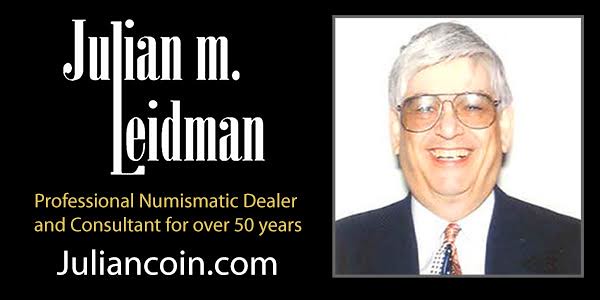
THE 1991 EAC MIDNIGHT SALE
Newman Numismatic Portal Project Coordinator Len Augsburger provided this report on the 1991 EAC Midnight Sale. Thanks. -Editor

Coins carefully arranged for the "Midnight Sale" auction lot viewing
What happens when numismatists and bibliophiles have an informal gathering? Compelled to memorialize minutiae – what the American Numismatic Society (ANS) motto calls "the little things" – we occasionally see works created that seem disproportionate to the import of the actual event. We'll see why that's not actually true, case in point being the 1991 EAC "Midnight Sale," a work recently scanned at the ANS under the sponsorship of Newman Portal. Ostensibly an auction catalog, but in reality a lovingly produced paean to the fellowship of colonial coin collectors, this document well conveys the convivial conclave that occurred in a hotel room in the early hours of April 28, 1991, during the Early American Coppers annual convention.
Billed as "worth getting out of bed for," the 24½ lot sale catalog (24 lots of Connecticut cents, the lone Vermont copper meriting only "half" a lot) features at least one page per lot with several full page photographs. Walter Breen was enlisted for the technical descriptions, and, whatever you think of Breen, there is no question that the man knew his Connecticut coppers. These descriptions were presented in Walter's familiar handwriting on "Howard Johnson" lot tickets, just the first sign of a low-brow affair.
The "terms and conditions" of the sale only reinforce the jocular mood, representing what every auction house wishes they could put in their boilerplate, but are prevented from doing so by the attorneys. "Under no condition shall bidding proceed in chronological order," or "This is a clean auction. No smoking, no drinking, no drugs, no….never mind, the cops are gone. Do what you want." In contrast to standard practice, the catalog itself was produced only after the sale, and even then distanced by several years. Most of the lots sold for under $100.
This document, though farcical on its face, well relates the spirit of the era. These collectors enjoyed coins, they enjoyed spending time with each other, and they were clever authors who could recreate the repartee in writing. Next to a time machine, this auction catalog is about the closest one can get to what must have been a rip roarin' good time.
Lot commentary, following the technical notes, well conveys the mood. "We don't know how this Vermont slipped in, and we do apologize for it. However, we note that researcher Gary Trudgen has not written an article on this variety which makes us suspect that it is even less interesting that we originally thought." All in all the work is a message to present collectors, that scholarship and stoogery (to "coin" a word) need not be mutually exclusive.

1991 EAC Midnight Sale group photograph
Link to The Midnight Sale:
https://archive.org/details/midnightsalepriv00ring/page/2
MORE ON ROBERT MARTIN AND THE MIDNIGHT SALE (https://www.coinbooks.org/v20/esylum_v20n48a17.html)
MORE ON DONALD J. LUTES JR.
We recently discussed Donald J. Lutes Jr. and his discovery coin, the first published 1943 copper cent which was recently sold by Heritage for $204,000. This article from The Berkshire Eagle profiles the quiet Pittsfield, Massachusetts collector who donated the proceeds of its sale to the Berkshire Athenaeum. -Editor
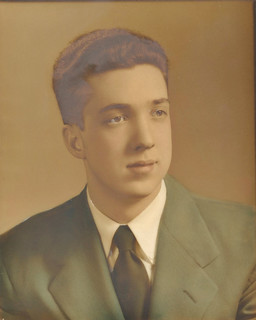 Lutes' place in numismatic history was cemented at auction when the penny garnered 30 bids and sold well above the pre-auction estimate of $170,000 to a Concord, Mass., collector, according to Heritage Auctions.
Lutes' place in numismatic history was cemented at auction when the penny garnered 30 bids and sold well above the pre-auction estimate of $170,000 to a Concord, Mass., collector, according to Heritage Auctions.
"This coin, for me, is certainly the 'Holy Grail' of mint errors. Rarely today does a discovery piece come to market, after all these years, still in the possession of the original owner," said David Camire, NGC grading finalizer and a mint error expert, in an article published on the NGC website in August.
But for Lutes, his passion for coin collecting seemed to go beyond his moment of steelie fame. In 1957, he joined the Berkshire Coin Club his dedication earned him the first-ever "Life Membership" by the club in 1974. A year later, he began a 40-plus-year avocation with the Berkshire Genealogical Society, forerunner to the Berkshire Family History Association. He served as BFHA president for 32 years, until 2017.
But that wasn't all. Lutes' tireless efforts to accurately index more than 1,500 items in the Berkshire Athenaeum's Local History and Genealogy Department earned him everlasting high praise. In 2007, the library renamed its annual volunteer award The Donald L. Lutes Jr. Volunteer of the Year Award.
"It was important for Don to be needed. The penny was just a story to him," said Ann-Marie Harris, senior technician/first assistant in the library's local history section.
A Berkshire Coin Club member since 1970, Karpenski noted in his eulogy of Lutes, he was a quiet leader.
"Don had a unique personality." he said. "He rarely spoke first, but when he did speak, it was the voice of a very intelligent individual."
Lutes' grandmother's death in the mid-70s sparked his interest in genealogy. She left him a box of papers and artifacts pertaining to the Lutes family history. As the only child of Donald Sr. and Pauline Lutes, he used those items to trace his lineage back to the state's earliest settlers, the Massachusetts Bay Company, Michael Collins recently wrote in a BFHA newsletter.
Lutes personal ancestral journey prompted him to help others chart their past. He later became BFHA president from 1985 to 2017.
He was so heavily involved in all aspects of the local history group, it now takes several people to handle the duties he assumed.
"We did a lot of head shaking and wondered, `How did he do all this?'" said current BFHA president, Jan Rogge.
As well known as Lutes was for his famous penny, genealogical expertise and indexing at the athenaeum, his personal life was a mystery to many. He was born March 1, 1931, and graduated from Babson College in 1951 with a degree in business administration. He then went on to serve as an Army cryptographic specialist with the U.S. Military Advisory Group to South Korea from 1952 to 1954. Upon his Army discharge, the war veteran joined his father's home-based Lutes & Son, manufacturing and marketing religious art products, including memorial statuary with internal lighting. The successful business eventually relocated into a factory on Fourth Street, where it flourished until the late 1970s. He rarely talked about being married to Isabel (Walsh) Parker from 1986 until her death in 1995. Lutes had no living immediate relatives when he died and often kept to himself away from his club/library activities.
Lutes was a creature of habit, regularly seen at a Friendly's restaurant in Pittsfield, ordering pancakes and a strawberry sundae.
Harris said the athenaeum staff, BFHA and coin club, were Lutes' family. She hopes more people also realize Lutes was more than that guy with a famous penny.
"I don't think we'll every find another one like him — one of a kind."
To read the complete article, see:
A one-of-a-kind find for a 'one-of-a-kind' collector
(https://www.berkshireeagle.com/stories/lutes-penny-a-one-of-a-kind-find-for-a-one-of-a-kind-collector,564312)
To read earlier E-Sylum articles, see:
MORE BREEN AND TAXAY AUTHENTICATION CERTIFICATES
(https://www.coinbooks.org/v21/esylum_v21n28a12.html)
BEARDLESS BREEN ON RADIO WITH 1943 BRONZE CENT
(https://www.coinbooks.org/v21/esylum_v21n30a08.html)
DISCOVERY SPECIMEN 1943 BRONZE CENT GRADED
(https://www.coinbooks.org/v21/esylum_v21n33a16.html)
MEDIA COVERAGE OF LUTES 1943 COPPER CENT
(https://www.coinbooks.org/v22/esylum_v22n02a28.html)
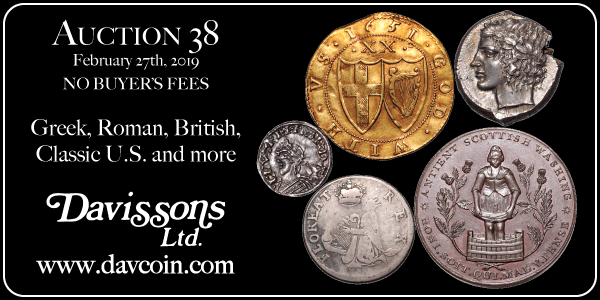
MORE ON JAMES C. RISK
Readers have more to add on Jim Risk. -Editor
Douglas Saville writes:
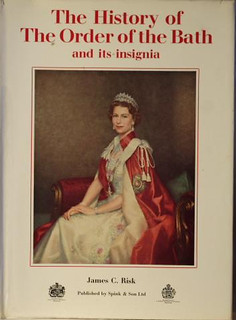 James C. (-harles) Risk (Jim Risk) was involved in Orders and Decorations, mostly, and foreign coins and medals and that's what he did at Coin Galleries, and he was close friends with Howard Linecar, the Head of Books at Spinks in the 1960s - early 1980s, until I took over in the mid-1980s. He was a closer friend with Douglas Liddell (DGL to everyone one at Spinks, and to all who knew him well). The reason for that was that Howard (HL) never travelled to the US - he would not fly - and DGL did go there - very often, and he had numerous good customers in the US; he did business with Stacks and with Jim Risk, of course, and Jim visited London frequently, as well.
James C. (-harles) Risk (Jim Risk) was involved in Orders and Decorations, mostly, and foreign coins and medals and that's what he did at Coin Galleries, and he was close friends with Howard Linecar, the Head of Books at Spinks in the 1960s - early 1980s, until I took over in the mid-1980s. He was a closer friend with Douglas Liddell (DGL to everyone one at Spinks, and to all who knew him well). The reason for that was that Howard (HL) never travelled to the US - he would not fly - and DGL did go there - very often, and he had numerous good customers in the US; he did business with Stacks and with Jim Risk, of course, and Jim visited London frequently, as well.
Jim headed Stacks' "Coin Galleries" in NY. He often visited London - and socialised with people connected with the Royal Household- I am sure he knew the Librarian at Windsor Castle quite well. Of course, Spink had three Royal Warrants then - HRH The Queen, HRH The Duke of Edinburgh and HRH The Prince of Wales. Spink were in King Street then, around the corner literally from St. James's Palace, and a 10 minutes' walk from Buckingham Palace.
He was a known expert on British Orders, and he wrote the ANS' Numismatic Notes & Monographs 106 on British orders and decorations (1945). His speciality was the history of the Order of the Bath and he wrote the book on that subject for Spink who published it in the late 1960s. I recall him as charming, but with a bit of a quick temper - he did not suffer fools at all- and a bit of a hard task master. I liked him, and I respected him a good deal.
Peter van Alfen of the American Numismatic Society writes:
When the ANS was preparing to move from Washington Heights down to the financial district in 2003-2004 we discovered in one of the old building's cavernous basements two rather large tightly wrapped tube-like bundles that bore tags identifying the owner: James Risk. Commander Risk, as we all knew him at the ANS (he'd been discharged from the Navy at the end of WWII with the rank of Lt. Commander), was a man of a different age, always quite formal and polite, yet very charming. He was, of course, still alive at the time although quite advanced in age.
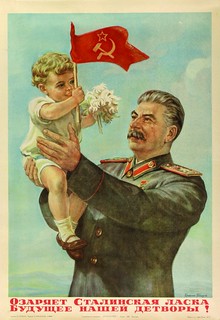 We called and he came by to see what these long forgotten bundles were all about. Upon seeing them he remembered. There were over 100 Russian propaganda posters in the bundles dating to 1946–1948. He had collected these while in Moscow in the years immediately after WWII ended while working for the State Department, buying them directly from the printers, but feared because of growing McCarthyism, that he would risk his job and much else if he were caught with them after returning to the US. Having served in the USSR, he was a prime target for suspicion.
We called and he came by to see what these long forgotten bundles were all about. Upon seeing them he remembered. There were over 100 Russian propaganda posters in the bundles dating to 1946–1948. He had collected these while in Moscow in the years immediately after WWII ended while working for the State Department, buying them directly from the printers, but feared because of growing McCarthyism, that he would risk his job and much else if he were caught with them after returning to the US. Having served in the USSR, he was a prime target for suspicion.
The solution to his dilemma, he decided, was to arrange to store them at the ANS, where he had been a member since 1939, until he felt it was safe to retrieve them. For over half a century they collected dust. Commander Risk very generously donated the posters to the ANS, which were featured in an ANS Magazine article I wrote for the summer 2005 issue ("Long Live Our Glorious Motherland! Posters and Medals from the Birth of the Cold War," vol. 4.2, pp. 16–33). You will note, however, that Commander Risk is not mentioned by name in the article. He wished to remain anonymous at the time because he still felt that any association with these instruments of communist propaganda might jeopardize his reputation, especially with the Queen.
He died on October 23, 2005, a few months after the article appeared. We still have the posters, hoping someday to find a buyer since obviously they don't quite fit in with the rest of the ANS's collection!
Here is a link to a digital version of the ANS Magazine article with many of the posters illustrated. (Note that we're having to use the Internet Archive Wayback Machine link since we're currently rebuilding parts of the ANS Magazine site):
https://web.archive.org/web/20121124075530/http://
ansmagazine.com/Summer05/Motherland
And here is a link to his obituary in the Spring 2006 issue of the ANS Magazine:
http://numismatics.org/magazine/riskspring06/
David Thomason Alexander writes:
Thanks for your remembrance of the late Lt. Commander James C, Risk, USN Ret. Jim was a true original, whose knowledge of world Orders and decorations was second to none. He was an expert witness in court actions involving spurious Orders, but found educating lawyers and judges in the intricacies of false decorations to be beyond mortal capability. With cataloging questions, I learned after joining Stack's-Coin Galleries in 1990, that one had to find him in a good mood! If he was not, one quickly found that a conversation with the Egyptian sphinx would be about as fulfilling.
Jim's ties to the Royal Family were genuine. He told me once of a visit to Arthur Durke of Connaught, who displayed his pre-1914 uniform as a Prussian Field Marshal and lamented the abandonment of the family's ancestral German titles during World War I.
As a State Department officer, it was his task to oversee the successful transfer of Embassy files back to the U.S. despite the avid attention of the Soviet intelligence services. His reward upon returning to America was to be placed on the "A List" of Wisconsin Senator Joseph R. McCarthy.
We are unlikely to see his like again, to paraphrase Shakespeare.
McCarthyism was ugly, and it's understandable that Risk would want to keep a low profile and avoid any appearance of a Russian connection. It must have left a scar to be felt so many years afterwards.
Thanks, everyone. -Editor
To read the earlier E-Sylum article, see:
MORE ON JAMES C. RISK
(https://www.coinbooks.org/v22/esylum_v22n05a14.html)
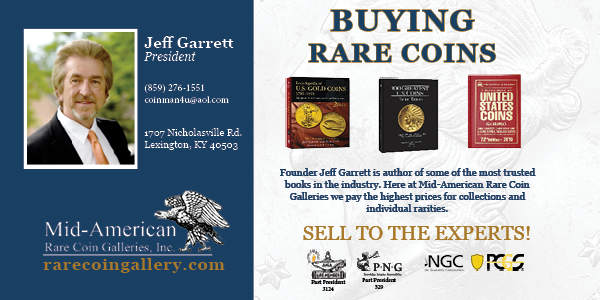
NOTES FROM E-SYLUM READERS: FEBRUARY 10, 2019
CAL Quarter Eagle Not a "True" Commemorative
Frank Crowe of Williamsburg VA writes:
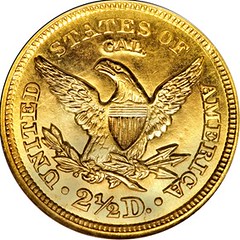 I do not believe that it is obvious that the U.S. Mint's first commemorative coin was the 1848 quarter eagle with the CAL counterstamp. There is no comparison between a hastily produced item, a counterstamped regular issue, with coins specifically designed as the result of the programs, commissions, surcharges, etc., associated with the production of what have, at least until recently, been considered the hallmarks of commemorative coins, classic or modern. The 1848 coin would better be described as a precursor or forerunner to commemorative coins. It is a true souvenir, but not a true commemorative coin, at least as generally defined. If you haven't guessed, I vote for the Columbian Exposition half as the Mint's first commemorative coin.
I do not believe that it is obvious that the U.S. Mint's first commemorative coin was the 1848 quarter eagle with the CAL counterstamp. There is no comparison between a hastily produced item, a counterstamped regular issue, with coins specifically designed as the result of the programs, commissions, surcharges, etc., associated with the production of what have, at least until recently, been considered the hallmarks of commemorative coins, classic or modern. The 1848 coin would better be described as a precursor or forerunner to commemorative coins. It is a true souvenir, but not a true commemorative coin, at least as generally defined. If you haven't guessed, I vote for the Columbian Exposition half as the Mint's first commemorative coin.
To read the earlier E-Sylum article, see:
COIN CIRCULATION IN 1860S CALIFORNIA
(https://www.coinbooks.org/v22/esylum_v22n05a11.html)
Goodspeeds Lesher Dollar
Regarding Lesher dollars,
Alan Weinberg writes:
 Almost 40 years ago there was a collectibles show in Denver immediately preceding the ANA. A bourse dealer had an EF Goodspeeds Lesher dollar priced at $1500. I'd never seen one and bought it on spec. I showed it around to supposedly knowledgeable numismatists who universally claimed I was buried at $1500.
Almost 40 years ago there was a collectibles show in Denver immediately preceding the ANA. A bourse dealer had an EF Goodspeeds Lesher dollar priced at $1500. I'd never seen one and bought it on spec. I showed it around to supposedly knowledgeable numismatists who universally claimed I was buried at $1500.
At the ANA a few days later I approached Lesher dollar collector Bill Henderson of Colorado and asked him if he collected Lesher dollars and what piece had eluded him. He replied "the Goodspeeds and I'd pay $5,000 for one if I found one." I pulled it out of my pocket. He was shocked, and many decades later his descendants exhibit it with the rest of his Leshers. I am shocked at the apparent current market value of $30,000 plus.
Great story. My apologies for not publishing this sooner - Alan's note got buried in my inbox. The image is from the excellent NLG gallery of the Henderson-Marchase Collection of Lesher dollars. -Editor
To view the Henderson-Marchase Collection, see: The Lesher "Referendum Dollars" (https://www.ngccoin.com/gallery/lesher/)
To read the earlier E-Sylum article, see:
BOOK REVIEW: FORGOTTEN COLORADO SILVER
(https://www.coinbooks.org/v22/esylum_v22n04a07.html)
Ultrathin USB Light Table For Examining Banknotes
 Kavan Ratnatunga of Sri Lanka writes:
Kavan Ratnatunga of Sri Lanka writes:
I purchased and got delivery after three weeks this A4 USB light table. Very useful for any banknote collector or dealer to look at and photograph watermarks on currency, and many other uses.
To more information, see: Ultrathin 3.5mm A4 LED Light Tablet Pad EU/AU/US/USB Plug Diamond Embroidery Diamond Painting Accessories Cross Stitch tool (https://www.aliexpress.com/item/Ultrathin-3-5mm-A4-LED-Light-Tablet-Pad-EU-AU-US-USB-Plug-Diamond-Embroidery-Diamond/32892138644.html)
Queen Anne: The Favorite

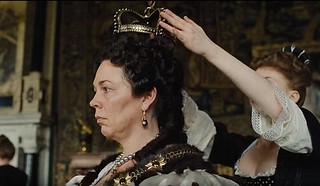
Vic Mason of Mamaroneck, NY writes:
I was intrigued that the monarch on the obverse of the very rare 1703 British Vigo gold coin, which recently sold at auction for 845,000 pounds, is Queen Anne (1665-1714), portrayed in the current Oscar-nominated film "The Favorite," which I happened to see this week. Actress Olivia Colman, whom I didn't know before, gives a superb performance of the Queen as homely, neurotic, infantile, often repulsive, yet proud, in her command of the deliciously decadent English court of the time.
In your photo of the coin, I was curious to see how closely the make-up artists were able to make Ms. Colman resemble the portrait on the coin. It wouldn't surprise me if images on the country's coinage of that era were an important resource for the film-makers.
The film gets an "R" because of the gratuitous exposure of a bit more skin than is necessary, some pretty salty language, and a few sexually titillating scenes that some might find unsuitable in "family entertainment." That said, it is a very well-made and well-acted film that makes the long-dead image on the 1703 Vigo gold coin come vividly to life for history-lovers.
Thanks for the film review. I haven't seen this one yet. -Editor
To read the earlier E-Sylum article, see:
VIGO FIVE GUINEA BRINGS RECORD PRICE
(https://www.coinbooks.org/v22/esylum_v22n05a22.html)
Book: The Golden Trade of the Moors
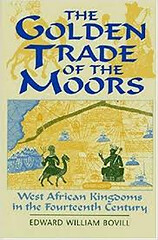 Dave Hirt of Frederick, MD writes:
Dave Hirt of Frederick, MD writes:
While reading about the Caravans of Gold exhibition, I was reminded of a book in my library, The Golden Trade of the Moors, by E W Bovill, London 1958. I believe that anyone interested in this subject would enjoy that book. It is very well researched, and has maps. I checked on Amazon, and reprints are available. Of nine people who rated it, eight gave it five stars, and one four. So that says something.
My copy came from the Joe Der library sold by John Bergman in 1993. It was an unsold lot I purchased following the sale.
Thanks! Check it out. -Editor
To read the earlier E-Sylum article, see:
BLOCK MUSEUM CARAVANS OF GOLD EXHIBIT
(https://www.coinbooks.org/v22/esylum_v22n05a17.html)
Uganda's 1981 Charles & Diana Commemorative
Martin Purdy of Upper Hutt, New Zealand writes:
The mention of The Man Who Stole Portugal in last week's newsletter reminded me a little of a tale in the latest Journal of the Numismatic Association of Australia (vol. 28, 2017), on a fraudulent attempt to commission a series of commemorative coins for Uganda in 1981.
The article by Barrie M Newman is titled "The story behind Uganda's 1981 Charles & Diana commemorative coin". It's a great tale of lies, secret bank accounts, clandestine meetings and diverted aircraft. -Editor
To read the complete article, see:
http://www.numismatics.org.au/pdfjournal/Vol28/naa-journal-vol-28-newman.pdf
To read the earlier E-Sylum article, see:
REIS SPURIOUS 1922 PORTUGAL 500 ESCUDOS NOTES
(https://www.coinbooks.org/v22/esylum_v22n05a29.html)

MORE ON THE PACIFIC COAST EXPOS BOOK MEDAL
Phil Iversen writes:
I just read the nice review by Eric Schena on the recently published book by Jeff Shevlin and William Hyder on So-Called Dollars From the Pacific Coast Expositions.
I contributed some items for the book including the die used to make the original So-Called dollar for the Exposition and the medal for the book as shown in the attached photos. The medal encased in the front cover is brass, but I used the bronze one as it photographs better.
Thanks. Here are Phil's photos. -Editor
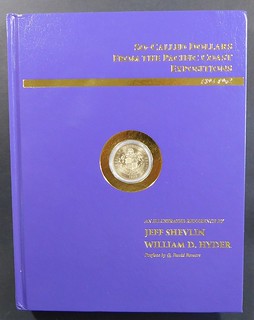
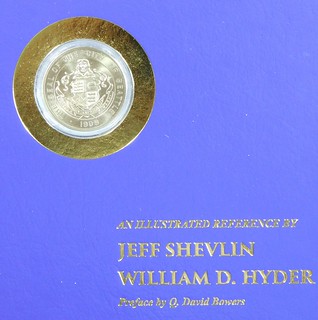
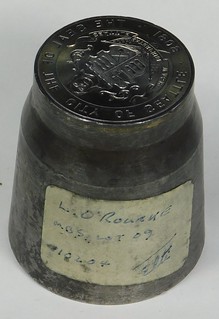
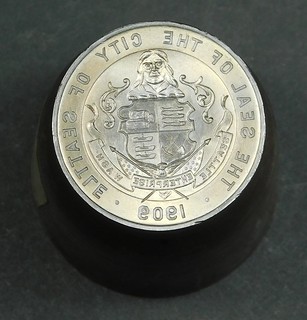
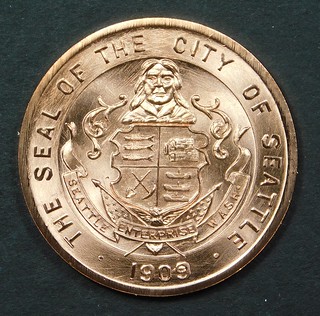
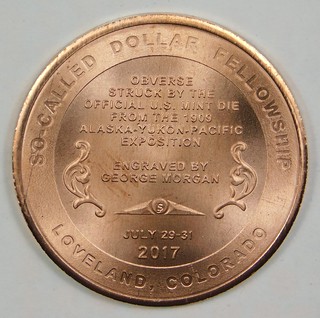
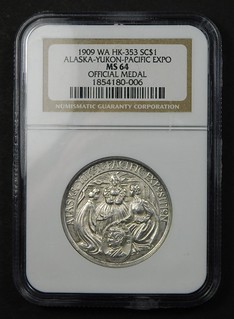

To read the complete article, see:
BOOK REVIEW: SO-CALLED DOLLARS PACIFIC COAST EXPOS
(https://www.coinbooks.org/v22/esylum_v22n05a06.html)
GARY BEALS: ZINC, YOU STILL STINK!
Gary Beals lives in Spain and is the author of Numiscadero, the 354-page Spanish-English Numismatic Dictionary. He submitted this follow-up to his May 2016 article on that lowly coinage metal, zinc. Thanks. -Editor
I told you zinc was lousy as a coin material back in May, 2016.
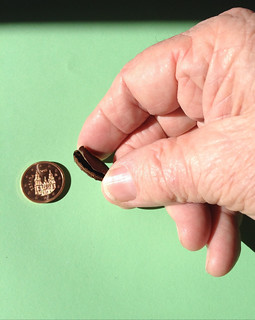 Now look: I found this 2001 2 centimo Euro coin in a crack of the ancient Roman aqueduct of Segovia, Spain (a 5 minute walk from our apartment). Someone thought it would be clever to hide a coin in one of the deeper seams of the 1900 year old granite structure.
Now look: I found this 2001 2 centimo Euro coin in a crack of the ancient Roman aqueduct of Segovia, Spain (a 5 minute walk from our apartment). Someone thought it would be clever to hide a coin in one of the deeper seams of the 1900 year old granite structure.
As you can see, the zinc sort of exploded into decay over the years after being exposed to moisture and some cold and heat. The copper plating on both sides is in good shape so the date and other details are clearly readable.
This coin wreck proves the report that you can dissolve the zinc out of a U.S. cent or a 1 or 2 Euro centimo coin leaving a fragile copper shell. As this snapshot shows, while the inner zinc has gone to pot, the copper faces of the coin are still preserved. Coins in the fountain? Bad idea. Zinc begins corroding in 48 hours. No wonder many banks refuse to accept corroded coins at full face value.
 A point from the "Zinc, you stink" article of 2016 —
A point from the "Zinc, you stink" article of 2016 —
Zinc is the cheap grey metal that is the material of choice when a government looks to make a near valueless coin. The thought of not making a coin so valueless does not seem to enter the minds of governmental leaders worldwide. Zinc is an apology by a government too cheap to produce a copper coin and too cowardly to abandon that now useless coin that no citizen really wants or uses.
The second photo is Gary in Roman garb in front of Segovia's Roman aqueduct. Thanks. If Roman coins had been made of zinc there would be few left to collect and study today. -Editor
To read the earlier E-Sylum article, see:
GARY BEALS: ZINC, YOU STINK!
(https://www.coinbooks.org/esylum_v19n22a13.html)

A 1924 IMMIGRANT'S PAPER MONEY
Dave Lange writes:
I was intrigued by John Lupia's account of Frederick William Bernet. It seems that this individual had several parallels with my paternal grandfather, Walter Lange. Both were born in Silesia while it was still part of Germany, my grandfather being ten years younger than Bernet. Walter Lange was born in Hirschberg, and it was mentioned that Bernet returned to that town periodically to visit his family. While Bernet was a Polish Jew, my grandfather was a Lutheran, yet many people in my family have commented that he looked ethnically Polish, and I concur with that assessment.
Both men were interned as enemy aliens for a time during WWI, my grandfather having jumped ship in San Francisco to avoid being drafted into Germany's navy. He was held briefly on San Francisco Bay's Angel Island before being sent to Pennsylvania to pick potatoes for the duration. Returning to Germany after the war and finding it offered nothing but misery, he emigrated legally in 1924.
The most restrictive immigration law ever passed in this country went into effect that year. It was very difficult to become a legal resident, and the process was a messy one that lasted some months.
I have a small parcel of inflation notes he had in his pocket when arriving in America to stay in 1924.
Interesting. Dave provided images of the notes. Thanks. For more information on German inflation and emergency money, see the related article supplied by Pablo Hoffman elsewhere in this issue. -Editor
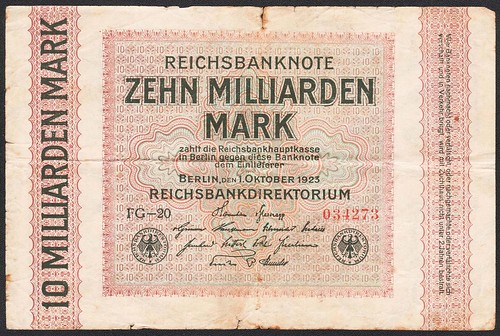
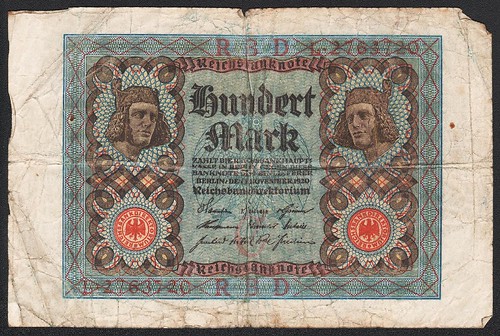

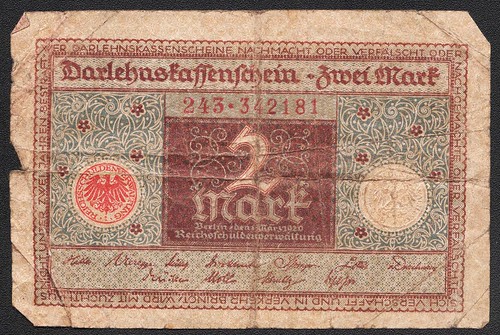
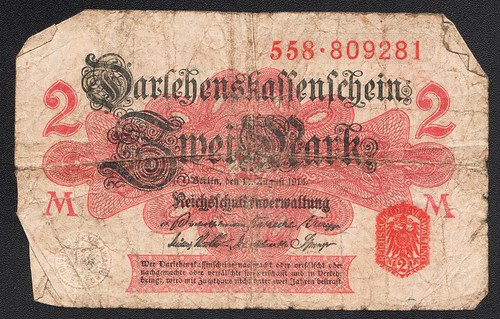
To read the earlier E-Sylum article, see:
FREDERICK WILLIAM BERNET (1887-1977)
(https://www.coinbooks.org/v22/esylum_v22n05a13.html)

VOCABULARY TERM: CHASING
Dick Johnson submitted this entry from his Encyclopedia of Coin and Medal Terminology. Thanks. -Editor
Chasing. The technique of working the surface of metal with chasing tools, finishing up and smoothing out the surface of castings, electroforms, galvanos and struck medals by removing small imperfections. It is said the chaser "moves metal around" but it is more than this in that it includes a variety of techniques – almost all handwork and performed at a bench – with a variety of tools, to produce an attractive and desirable metal surface.
The chaser's job is two kinds: flat chasing creating in effect a design or relief on the front of a flat metal surface, as a cisele item; and finish chasing, a smoothing of cast or formed relief where needed, as on repousse or cast and chased items. The aim of such work is to emphasize the existing design; the chaser is the artisan or craftsman who makes the artist's design look even better in sculptural form. He receives the work from the foundry, the casting mold, the electroforming tank or the pressroom and he hand tools each piece to eliminate imperfections – to "remove the warts" – and make it look the best it can be.
From the chaser's bench the completed work usually goes to the finishing department which applies color and lasting patina. If the end product looks smooth where it should be smooth, textured where it should be textured, and sharp where it should be sharp, then the chaser has done his job well. Often this is so subtle it is undetectable. Thus, the public seldom learns of the skilled handwork of the chaser and his effort is mostly unnoticed and unsung.
Wide Variety of Chasing Tools
The chaser uses some of the same tools as the engraver – burins, gravers, scorpers
and chisels – but has some unique tools of his own: chasers, liners, tracers, raisers, dapplers and matting tools. In addition he uses a variety of files, rifflers, punches, mallets, burnishers, grinders, stones; and chasing hammers.
All told a chaser could have 50 to 100 different tools at his disposal. Chasing tools are available commercially, or the experienced chaser will make his own. The chasing hammer is universally used – it is small with a flat head. In use the chaser watches the end of the chasing tool and not the hammer, thus the reason for the broad head.
The size of the piece and the area to be worked dictates the selection of the tool to be used, some of which are described below in what the tool accomplishes.
Removing Raised Lines, Bosses &Burrs
The nature of casting, no matter what size or kind, is such there are always tiny flaws that need to be removed from the surface. These are generally caused by dirt, trapped gasses, mishandling or accident during the casting. Thus every roughcast has to be chased to remove such surface imperfections. Mostly these are raised bosses, which usually appear near large detail, rims and edges of lettering and detail.
Raised lines, lumps, blisters, bosses and burrs can be chiseled away, ready for smoothing. Dirt causes blisters. Trapped gas that caused pits in the pattern will cause bosses on the piece cast from that pattern. Electroformed or galvano pieces all need attention. Any piece that has been machined, trimmed or sawcut may have burrs that need to be removed. All these receive the attention of the chaser.
While not as prevalent as in casting, diestruck pieces can also have raised imperfections (particularly from older dies). Diecracks, diebreaks and fractures in the die causes lines on the struck piece. Holes or dents in the die causes raised bosses. Rusted dies have rust pits in the die and raised nodules on the struck piece. Medals with insert dies need to be cleaned up generally (a line usually forms around the insert where it seated in the die).
Chisels are used foremost to remove raised lines of bosses. Smoothing is then accomplished by burnishers, by grinders, by stoning or by emery cloth.
Removing Pits, Holes &Nicks
Pinholes and more serious dents, gouges, holes and pitting are removed by burnishing. The concave area is filled by moving adjacent surface metal toward, and filling in the unwanted depression, feathering the surrounding area until the depression is no longer perceptible to the human eye.
Removing a hole in the field where the surrounding area is flat is less difficult than repairing a hole where this is in the detail or relief. Care must be exercised so the artistic effect of the detail is not lost to the viewer. Edge nicks are a more serious problem also, because of the difficult of drawing metal from the area surrounding the nick.
Planchet flaws infrequently present work for the chaser. Cracked or defective planchets, laminations or alloy imperfections generally leave sunken furrows with sides folded over from die striking. If it is necessary to save the piece (rather than rejecting it and striking another) the chaser can remove the imperfections by burnishing and smoothing.
Diestruck pieces may also have "lint" marks, ghosting (or suction) marks, or more serious impressed foreign objects (dirt, scrap, diechips or such) which need to be removed and chased. The burnishing tool is most used for this work. It is slightly curved, comes to a point, has a polished surfaces and is very hard.
Patching Holes
For the most serious holes where it is impractical to draw metal from the surrounding area, a patch or plug must be made. Undercuts are made all around the hole to build a mortise. A plug of the same metal as the piece being filled is hammered in, cut off and smoothed out flat with the surrounding area.
Deepening Relief
Incised detail can be emphasized by the chaser. Here he would use some of the engraver's tools to carve out metal where lines and crevices need to be deepened. He can enhance lettering by sharpening up their from and serifs. Specifically for diestruck pieces he can work on clogged letters and filled dies. Tiny projections on a die (like the open top of a cap A) are susceptible to breaking off in the die leaving a filled area on the struck piece. These are cleaned out by the chaser. (This work could have been prevented by the champs levee process.)
An annealing distortion or worn die may leave indistinct detail on the struck piece. If it warrants, the chaser can deepen this, as well as enhance lettering, monograms and small relief. He may also work on the die itself – recutting, reengraving or refurbishing the die (if an engraver is not available to do this).
Any tool that can "bite in" can be used for deepening relief: burins, gravers, chisels and such; often with a mallet.
Smoothing Surfaces
The grainy surface of a casting most often needs to be smoothed out; this occupies more time of a chaser than any other activity. Smoothing of a flat field is easy for the experienced chaser, more care needs to be exercised for surface detail and relief. Smoothing usually removes all tool marks and other small imperfections. In addition to finishing pieces, smoothing is also done on metal patterns and some molds.
The smoothing is accomplished by burnishing, by filing, by lapping, by grinding (both hand and mechanical), with emery or oil stones, or by hand with emery cloth, or by polishing with any of several polishing compounds.
Matching or Adding Texture
By the use of special tools medallic surface may be given texture or background design. When a large detail is smooth, for instance, the artist may want texture in the field for contrast. The chaser can accomplish this in a variety of textures: crosshatched, checkered, dappled, matte, mottled, pebbled, shaded, speckled, stippled and striated.
Most of this is performed in the field of the piece; when chasing work is done in the relief the chaser must, of course, match the molded relief or adjacent texture, whatever that is. Each of these surface textures has its corresponding tool and here is where matting, dappling and chasing tools come into play; again often used with the mallet.
Trimming &Miscellaneous Work
Some trimming is done in the pressroom with trimming dies – all other trimming is done by hand and this is the responsibility of the chaser. The openwork, piercing, silhouetting is done by a chaser with a jeweler's or coping saw on small pieces, band saw on larger pieces. He must remove the burrs after this, of course, and continue with normal smoothing and chasing where needed.
A variety of other functions can be done by the chaser, although these are infrequently called for. These might include brightcut or surface scraping for a jewelry finish) or such chores as inlay work.
Chasing Repair &Restoration
Impaired medals may be repaired (coins are seldom repaired other than plugging a hole). The chaser can plug holes, remove spots and corrosion, repair dents, gouges, scratches and edge nickels – provided these are not too advanced or too serious.
The first step is to delacquer and clean, then determine the base metal of the piece to be repaired – (usually an experienced chaser can do this by observing color and testing hardness). If the piece is plated he must first do a reverse plating (stripping away the plated material) before proceeding.
Then he performs his chasing work on the base metal; replating (if necessary) then applying the finish – antique or whatever – and finally relacquering. Generally this restoration work is on a small area (or small medallic item) and the tools used by the chaser reflect these size requirements.
Enchasing
Creating raised relief design – not by striking or embossing – but by raising a design on the surface of metal
is called enchasing. The surface is brought up by chasing tools, creating raised bosses, or by indentations, called flutes. Examples of this might be a watch case, but this would only be for a one-of-a-kind item, because of the ease of producing this form of relief by embossing.
Looking for the meaning of a numismatic word, or the description of a term? Try the Newman Numismatic Portal's Numismatic Dictionary at: https://nnp.wustl.edu/library/dictionary
Or if you would like a printed copy of the complete Encyclopedia, it is available. There are 1,854 terms, on 678 pages, in The Encyclopedia of Coin and Medal Technology. Even running two a week would require more than 19 years to publish them all. If you would like an advance draft of this vital reference work it may be obtained from the author for your check of $50 sent postpaid. Dick Johnson, 139 Thompson Drive, Torrington, CT 06790.

JOSEPH FRANCIS NEGREEN, JR. (1881-1924)
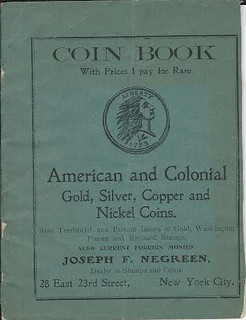 Joseph Francis Negreen, Jr., was a popular "Coin and Stamp Dealer," operating at various offices along East 23rdStreet, New York City, New York, the same blocks where we also find Scott Stamp &Coin, Ltd., Thomas L. Elder, and Lyman Haynes Low. Negreen also traded there as the Greater New York Stamp &Coin Company.
Joseph Francis Negreen, Jr., was a popular "Coin and Stamp Dealer," operating at various offices along East 23rdStreet, New York City, New York, the same blocks where we also find Scott Stamp &Coin, Ltd., Thomas L. Elder, and Lyman Haynes Low. Negreen also traded there as the Greater New York Stamp &Coin Company.
Joseph Francis Negreen, Jr. (1881-1924), was born on March 7, 1881 in New York City [some records report born in Bohemia, i.e., Austria], son of Joseph Francis Negreen, Sr. (1857-) and Katherine (1858-) were Bohemian - Austrian immigrants.
A James Frank Negreen was a stamp dealer in Omaha, Nebraska. So far no connection has been made between these two men.
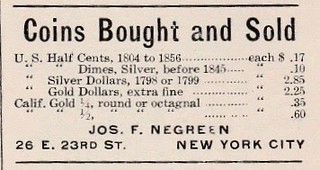 In the May 15, 1904 issue of the American Journal of Philately, page 115, "The Case of R. P. H. Wolle," we read that Joseph Negreen was one of the key witnesses in this unprecedented forgery case. It is unprecedented since there were neither previous court cases of philatelic forgeries nor any previous court case involving any stamp dealers in the annals of the New York judiciary. It was Negreen who brought about New York's first trial case involving philatelic forgeries.
In the May 15, 1904 issue of the American Journal of Philately, page 115, "The Case of R. P. H. Wolle," we read that Joseph Negreen was one of the key witnesses in this unprecedented forgery case. It is unprecedented since there were neither previous court cases of philatelic forgeries nor any previous court case involving any stamp dealers in the annals of the New York judiciary. It was Negreen who brought about New York's first trial case involving philatelic forgeries.
The 1905 NY Census lists him as a Bohemian, as single, and working as a Coin Dealer.
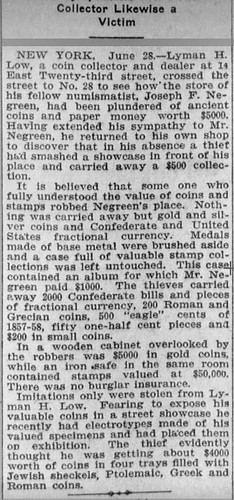 In the Los Angeles Herald, Saturday Morning edition, July 18, 1908, "Rare Coins Stolen From Numismatist," relates how Lyman H. Low visited Negreen after having been robbed of $5,000 worth of ancient coins and paper money. Low is reported to return to his shop finding the sidewalk display case was smashed open and $500 in coins were reported stolen. The replicas that were stolen were of Jewish shekels, Ptolemaic, Greek, and Roman coins.
In the Los Angeles Herald, Saturday Morning edition, July 18, 1908, "Rare Coins Stolen From Numismatist," relates how Lyman H. Low visited Negreen after having been robbed of $5,000 worth of ancient coins and paper money. Low is reported to return to his shop finding the sidewalk display case was smashed open and $500 in coins were reported stolen. The replicas that were stolen were of Jewish shekels, Ptolemaic, Greek, and Roman coins.
In the August 1908 issue of The Numismatist, page 238, Negreen's stamp and coin shop is reported to have been robbed on the night of June 9th of both coins and stamps worth $5,000, a considerable amount. Fortunately, they, for some unaccountable reason, probably hurried off when Negreen was coming back, did not steal the gold coins leaving that case untouched. Lyman H. Low, who also was also robbed had been fortunate enough to have them steal his replicas in the sidewalk display case, apparently thinking they were real.
To read the complete article, see:
NEGREEN, JOSEPH FRANCIS, Jr.
(https://sites.google.com/a/numismaticmall.com/www/numismaticmall-com/negreen-joseph-francis)
The entire inventory of the Lupia Numismatic Library is for sale. Individual items will be available before the remaining archives are broken up into parcels sold at philatelic auctions in the U. S. and Hong Kong. Check NumismaticMall.com frequently as dozens of new items with estimates will be posted daily until everything is sold.
All inquiries will be given prompt and courteous attention. Write to: john@numismaticmall.com .
HARVEY STACK'S NUMISMATIC FAMILY, PART 37
Harvey Stack's blog series focuses on living in a numismatic family. Here is part 37. Thanks, Harvey! -Editor
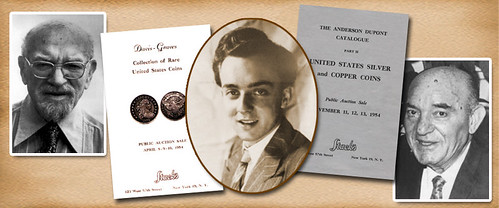
For Stack's, 1965 was a very demanding year. Beginning in this year, the U.S. Mint stopped making dimes and quarters out of silver and reduced the silver content of the half dollar to 40%. All the dimes, quarters and half dollars struck in 1964 or earlier were left in circulation by the Mint. Like all things that are predicted to become scarce, the public, collectors, and investors started to buy them up. Shortly after the announcement of change in the coins' make up by the Mint, hoarding began and such coins were removed from circulation. The public awaited a rise in price, so they could sell them at a profit. In the beginning, there were so many that the price over face value did not make hoarding them worthwhile. But as in all such situations, there were many who believed the coins would become profitable and that silver in the future would be a great investment. Newspapers and other publicity made much of this "great investment," and the public responded by further hoarding.
In addition to the shop being full of people looking to profit from silver, my time was taken up with working with our attorneys in Washington, D.C. preparing our action against the Office of Gold and Silver Operation (OGSO) because of the restrictions on importing of gold coins (to be discussed later).
The year 1964 had been somewhat lean for Stack's with regard to major public auction sales. Collectors had started to worry that the Treasury might try to change the Gold Reserve Act of 1933-1934 that restricted the ownership of gold coins, unless you were a collector. There was concern that since silver was being taken out of our coins, maybe the Treasury would want to try to gather all silver coins. As it would have required an Act of Congress, it was unlikely. But these rumors, and other factors, including the restrictions on imports, made both buyers and sellers wary of what was in the future.
Fortunately, rulings came down that the OGSO was interested only in gold coins that might be sent by counterfeiters to the United States. The goal of the Secret Service (who had seized counterfeits which were in the United States in previous years) was getting false coins out of the marketplace.
I spent days and weeks in Washington trying to find out how the OGSO determined what was a counterfeit and therefore should be seized. In general, they were not interested in numismatic, collectible coins. They had a list so their agents could more quickly determine what was to be allowed and what was to be banned. Yet they did not make that list public, so the question remained, "What was the criteria they were using to issue import licenses?" People in the coin hobby had no idea what references were being used or if the Customs House had experts who knew the difference between real and false coins.
This continued to be a problem for the collection that Stack's was trying to bring to the United States from the Netherlands: about 900 different gold coins of the world, a major collection for sure. From the inventory list we submitted, the government wanted to consider licensing only 725 pieces and restrict about 175 pieces from entry. This despite the fact that they never actually saw any of the coins in the collection. Our attorneys, on our behalf, demanded to know what was the basis for denial of these coins. That was the main question of our lawsuit.
Since Stack's had built a good relationship over the years with the Netherlands collector, he agreed to wait and see the outcome of the case, and keep the collection for auction in the future, once we got the license. He did not wish to break up the collection and appreciated that we were willing to spend the time and legal costs to get his collection into the United States. So, we proceeded. But at this point mostly we were forced to wait and wait some more!
I confirmed with Harvey that in this sentence "There was concern that since silver was being taken out of our coins, maybe the Treasury would want to try to gather all gold coins. " should be "... try to gather all silver coins." Thanks. I made the correction above. -Editor
To read the complete article, see:
Harvey Stack Remembers: Growing Up in a Numismatic Family, Part 37
(https://www.stacksbowers.com/News/Pages/Blogs.aspx?ArticleID=3271)
To read the earlier E-Sylum article, see:
HARVEY STACK'S NUMISMATIC FAMILY, PART 36
(https://www.coinbooks.org/v22/esylum_v22n04a19.html)

JOSEPH MENNA APPOINTED TO CHIEF ENGRAVER
The United states Mint published a press release on February 4, 2019 about the appointment of Joe Menna as Chief Engraver. -Editor
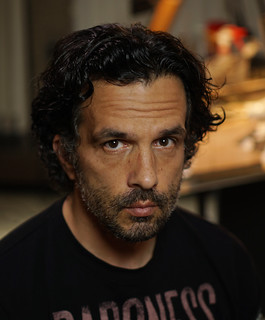 United States Mint Director David J. Ryder announced that Sculptor-Engraver Joe Menna has been named Chief Engraver of the United States Mint.
United States Mint Director David J. Ryder announced that Sculptor-Engraver Joe Menna has been named Chief Engraver of the United States Mint.
Menna joined the Mint in 2005, and he brings 32 years of professional experience and classical training to the position. He was the first full-time digitally skilled artist hired by the United States Mint. Menna was instrumental in the development of the United States Mint's first digitally sculpted coins and continues to distinguish himself as a leader in this constantly evolving craft.
Prior to joining the Mint, Menna worked as a sculptor and instructor at the Johnson Atelier Fine Art Foundry in Mercer County, N.J., creating life-sized figures and working digitally on projects for a variety of clients. Concurrently, he pursued his own sculpting and created many works, notably a seven-foot tall cupro-nickel statue for the Grounds for Sculpture and a temporary 30-foot tall monument for the Hamilton train station in Hamilton, N.J.
His work has won multiple Krause Publications' Coin of the Year awards in various categories. Menna has been honored both for coins he sculpted and designed, and for coins he sculpted from other artists' designs. In addition to his work at the United States Mint, he maintains an active freelance career in toys and collectibles, and he is recognized as one of the world's leading practitioners of digital sculpture.
Menna holds a Bachelor of Fine Arts degree in sculpture from the University of the Arts, a Master of Fine Arts degree in sculpture from the New York Academy of Art, with post- graduate study at the Saint Petersburg Stieglitz State Academy of Art and Design in St. Petersburg, Russia. His continuing professional education includes studies at the Pennsylvania Academy of Fine Art, the Sculpture Center, and the Art Students League.
The release includes lengthy lists of his coin and medal output - see the complete release online. -Editor
To read the complete press release, see:
Joe Menna Named Chief Engraver of the United States Mint
(https://www.usmint.gov/news/press-releases/joe-menna-named-chief-engraver)
See the excellent Mint News Blog by Brandon Hall (linked below) for additional information and images of Menna and his work. -Editor
To read the complete article, see:
Joseph Menna brings his unique portfolio of talents to the position of chief engraver
(https://mintnewsblog.com/joseph-menna-brings-his-unique-portfolio-of-talents-to-the-position-of-chief-engraver/)
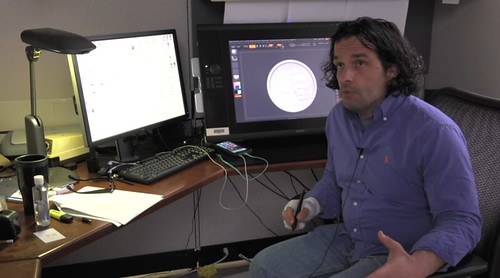
To read the earlier E-Sylum articles, see:
JOESPH MENNA: DESIGNER OF WASHINGTON AND JEFFERSON DOLLAR COIN PORTRAITS
(https://www.coinbooks.org/esylum_v09n49a21.html)
U.S. MINT PROFILES MEDALLIC SCULPTOR JOSEPH MENNA
(https://www.coinbooks.org/esylum_v17n51a16.html)
VIDEO: U.S. MINT SCULPTOR JOSEPH MENNA
(https://www.coinbooks.org/v20/esylum_v20n11a14.html)
DR. DEAN J. KOTLOWSKI APPOINTED TO CCAC
The Citizen's Coinage Advisory Committee has a new member - Dr. Dean J. Kotlowski. Here's his bio from the CCAC web site. The site doesn't have a photo of him yet, but I found one on the Ohio University College of Arts & Sciences Forum. -Editor
 Dr. Kotlowski is Professor of History at Salisbury University. A specialist in twentieth-century US political and policy history, he received his Ph.D. and M.A. from Indiana University and his B.A. from Canisius College. He is the author of Nixon's Civil Rights: Politics, Principle, and Policy and Paul V. McNutt and the Age of FDR, and the editor of The European Union: From Jean Monnet to the Euro. Professor Kotlowski has published forty articles and book chapters in the US, UK, Australia, Austria, Germany, Denmark, Finland, and Russia. He has lectured in twenty-two countries and has twice served as a Fulbright Scholar, in the Philippines (2008) and Austria (2016).
Dr. Kotlowski is Professor of History at Salisbury University. A specialist in twentieth-century US political and policy history, he received his Ph.D. and M.A. from Indiana University and his B.A. from Canisius College. He is the author of Nixon's Civil Rights: Politics, Principle, and Policy and Paul V. McNutt and the Age of FDR, and the editor of The European Union: From Jean Monnet to the Euro. Professor Kotlowski has published forty articles and book chapters in the US, UK, Australia, Austria, Germany, Denmark, Finland, and Russia. He has lectured in twenty-two countries and has twice served as a Fulbright Scholar, in the Philippines (2008) and Austria (2016).
Dr. Kotlowski has extensive experience in public history. He was a member of a four-person team of internationally-renowned historians who oversaw the first-ever comprehensive reconfiguring of museum exhibits at the Richard Nixon Library in Yorba Linda, California. In addition to extensive lecturing before academic, community, senior citizen, and student groups, he has spoken numerous times on National Public Radio and has appeared thrice on C-SPAN, including in their "Lectures in American History" (2012) series."
To read the complete article, see:
Dr. Dean J. Kotlowski
(https://www.ccac.gov/aboutUs/bio_kotlowskiDean.html)
For more information on CCAC, see:
https://www.ccac.gov/
THE BOOK BAZARRE
MARCH 2019 ANA MONEY TALKS
There are some great talks lined up for the ANA National Money Show next month in Pittsburgh. Here's the schedule. -Editor
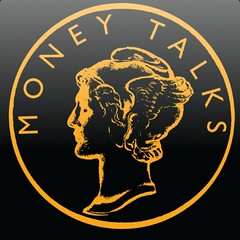 Money Talks provide members a forum in which to share their views and research with fellow hobbyists. The numismatic lectures are presented each year at ANA conventions and are free to attend. Presentations are 30 to 45-minute programs, including questions from the audience.
Money Talks provide members a forum in which to share their views and research with fellow hobbyists. The numismatic lectures are presented each year at ANA conventions and are free to attend. Presentations are 30 to 45-minute programs, including questions from the audience.
Thursday, March 28
10 a.m. Barbara Gregory
"Steering the Course of the Hobby's Flagship Publication"
11 a.m. Mark Gatcha
"Civil War Storecards: Latest Research and New Finds Since the 3rd Edition"
12 p.m. Rob Throckmorton & Richard Gaetano
"Lewis and Clark's Impact on U.S. Coinage and Currency, and Pittsburgh's Role in this Historic Expedition"
1 p.m. Douglas Mudd
"Money of Empire: Elizabeth to Elizabeth"
2 p.m. Lawrence C. Korchnak, PhD.
"Siege Notes: The Currency of War"
3 p.m. Rod Gillis
"Strategies to Dispose of Your Collection"
Friday, March 29
10 a.m. Paige Price
"What's In Mickey's Pocket: Disney Dollars"
11 a.m. Don Everhart
"Don Everhart: A Career in Coin Design"
12 p.m. E. Tomlinson Fort
"Rex Magnae Britanniae: The Final Coinage Reform of James VI of Scotland"
1 p.m. Leo Wang
"Future Trends of Traditional Coin Collecting in Modern China"
2 p.m. Simcha L. Kuritzky
"Astrological Calendar Medals of the Vienna, Austria Mint"
3 p.m. Antonino Crisà
"Never Say 'Banal' Objects: Tokens and Erotic Tesserae from Hellenistic and Roman Sicily"
For additional information contact Sam Gelberd at sgelberd@money.org.
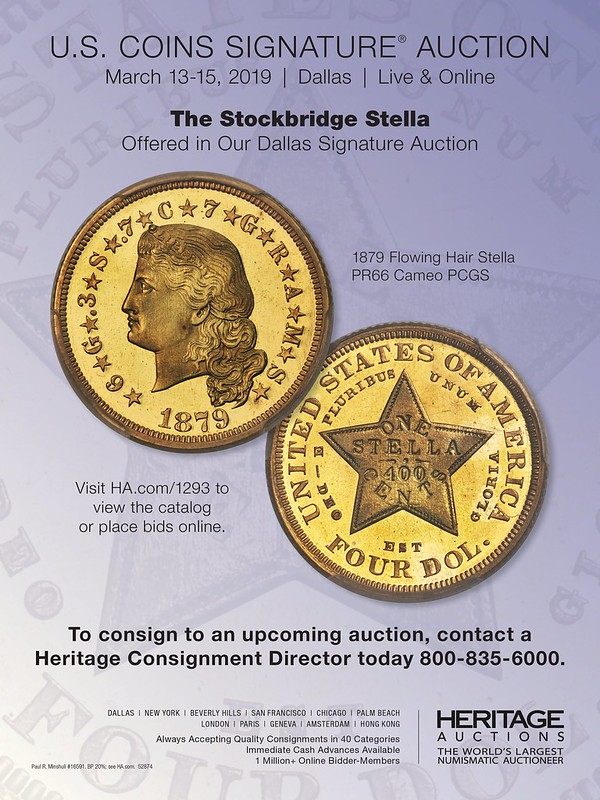
INTERNATIONAL PAPER MONEY SPEAKERS SOUGHT
The 2019 International Paper Money Show is a great opportunity for collectors and researchers to share their knowledge with the community. Here's an excerpt from the Call for Papers. -Editor

International Paper Money Show
June 13 (Thursday) -16 (Sunday), 2019
Sheraton Kansas City Crown Center Hotel
Kansas City, Kansas
Kansas City here we come!
IPMS is the paper money speaking event of the year! Gain the cachet of giving your great presentation at the IPMS!
Show information at: http://www.ipmskansascity.com/
We invite presentations on any fiscal paper or fiscal paper tie-in topic. We will have a packed program. We always want new speakers with new topics! Please pass this on to anyone you think might want to contribute.
Deadline for submissions is April 1, 2019
Talks are scheduled on Friday and Saturday (June 14 & 15) on the hour. Each speaker is allotted 50 minutes, which includes time for questions.
You are encouraged to mount a parallel exhibit in the exhibition area. Check the IPMS website for exhibit details.
Peter adds:
As chair of this thing, what I am always looking for is CREATIVITY. I am wide open to any viable topic pertaining to any facet of paper currency or collectable monetary paper instruments, particularly talks that place collectables in some larger, even unexpected, context. The programs that draw are those that contain NEW RED MEAT - particularly if the coverage involves the PEOPLE and ACTION behind the notes, be it those who were responsible for an historic event involving some collectable or those who made a truly significant contribution to numismatics.
Top draws have been presentations on the Treasury officials in the FDR Treasury who redefined U. S. currency and in the process saved the economic fabric of the country during the Great Depression and the story of Col. Green who singlehandedly was responsible for saving the vast majority of number 1 Series of 1929 national bank notes.
Which talk would you rather attend? Would you prefer to engage Key Pittman as one of the greatest numismatic heroes or one of the greatest numismatic villains or would you prefer to delve into an arcane discourse on some minute engraving variety on some early $1 silver certificate? Just pitch something to me that successfully answers this challenge and you'll be welcomed with open arms. More than this, I simply can't say.
For more information, contact Peter Huntoon at:
peterhuntoon@outlook.com
Please consider it. Here are titles of talks from recent years. -Editor
2017
•
Joseph Boling: The making of a specialist
•
Steve Carr: National banks and notes from the other Kansas City
•
Carlson Chambliss: 106 years of Hawaii currency from scrip to WW II
•
James Ehrhardt: Iowa obsolete currency where private issues were banned
•
Peter Huntoon: George Casilear's patented lettering on large-size U. S. currency
•
Peter Huntoon: How intaglio printing plates were made
•
Lee Lofthus: Are the published outstanding National Bank Note data any good?—the big
picture!
•
Wendell Wolka: Old tales connected to obsolete paper money and banking
•
Jamie Yakes: Series of 1928 Federal Reserve Notes
2018
•
Bill Brandimore:
Collecting small size Federal Reserve notes with an emphasis on $5s
•
Joseph Boling:
How fakers messed up their products—laziness or ignorance
•
Robert Calderman:
Cherry Picking 101: How to score amazing notes without breaking the bank!
•
Steve Carr:
Inside Kansas Nationals—One amazing tale on top of another
•
Carlson Chambliss:
Philippine emergency paper money, 1941-1945
•
Ray and Steve Feller:
Overprints on WWII Currency
•
Jerry Fochtman:
Dr. Daniel W. Valentine—postage and fractional currency & half dime pioneer
•
Pierre Fricke:
Counterfeit Confederate money made in the Union
•
Peter Huntoon:
New Deal Money, the creation of money during the Great Depression
•
Roger Urce:
Japanese Colonial Issues for Taiwan
•
Wendell Wolka:
Confederate Printers—the Good Bad and Ugly
Jamie Yakes
R & S experimental $1 1935A silver certificates

NEWMAN GRADUATE SEMINAR IN NUMISMATICS
The American Numismatic Society's annual Eric P. Newman Graduate Summer Seminar in Numismatics will take place in New York this June and July. -Editor
Graduate Summer Seminar in Numismatics
June 3 through July 26, 2019
Study at the Foremost Seminar in Numismatic Methods, Theory, and Data Science
 For over half a century, The American Numismatic Society, a scholarly organization and
museum of coins, money, and economic history, has offered select graduate students and
junior faculty the opportunity to work hands-on with its preeminent numismatic collections.
With over three-quarters of a million objects, the collection is particularly strong in Greek,
Roman, Islamic, Far Eastern, and US and Colonial coinages, as well as Medallic Art. Located
in New York City's SoHo district, the Society also houses the world's most complete
numismatic library.
For over half a century, The American Numismatic Society, a scholarly organization and
museum of coins, money, and economic history, has offered select graduate students and
junior faculty the opportunity to work hands-on with its preeminent numismatic collections.
With over three-quarters of a million objects, the collection is particularly strong in Greek,
Roman, Islamic, Far Eastern, and US and Colonial coinages, as well as Medallic Art. Located
in New York City's SoHo district, the Society also houses the world's most complete
numismatic library.
The rigorous eight-week course, taught by ANS staff, guest lecturers, and a Visiting Scholar, introduces students to the methods, theories, and history of the discipline. In addition to the lecture program, students will select a numismatic research topic and, utilizing ANS resources, complete a paper while in residence. The Seminar is intended to provide students of History, Art History, Textual Studies, Archeology, and Data Science who have little or no numismatic background with a working knowledge of a body of evidence that is often overlooked and poorly understood. Successful applicants are typically doctoral candidates or junior faculty in a related discipline, but masters candidates are admitted as well.
This year's Eric P. Newman Visiting Scholar will be Dr. Evangeline Markou of the National Hellenic Research Foundation. Dr. Markou is a specialist in ancient Greek coinage, particularly the coinage of ancient Cyprus.
Applications are due no later than February 22, 2019. A limited number of stipends of up to $4000 are available to US citizens, and non-US citizens studying at US institutions under certain visas. For application forms and further information, please see the Summer Seminar page of our website: numismatics.org/seminar, or contact the Seminar Director, Dr. Peter van Alfen (vanalfen@numismatics.org; 212-571-4470, x153).
For mroe information, see:
http://numismatics.org/seminar/
ANCIENT GREEK AND ROMAN NUMISMATICS SCHOOL
The third Summer School on Ancient Greek and Roman Numismatics takes place this July in Athens. -Editor

The Institute of Historical Research of the National Hellenic Research Foundation, one of the most important establishments for the research and study of the Greek history (ancient, medieval and modern) at international level, is pleased to announce the organisation of its third Summer School on Ancient Greek and Roman Numismatics, to take place at its premises in Athens, from 1 to 10 July 2019.
The ten-day intensive Summer School aims at familiarising those who have little or no background with the discipline of numismatics by offering a series of introductory courses in numismatics, visits to major numismatic collections in Athens, as well as guided visits to archaeological sites in Attica.
The courses provide a chronological survey of ancient Greek and Roman coinage (from the pre-monetary period down to Roman times), combined with lectures on numismatic methodology and other more specialised topics. For 2019 there will be an emphasis on the information coinage can provide on ancient cults, on evidence concerning coinage in a ritual context, combined with guided visits to important sanctuaries in Attica.
The Summer School on Numismatics is addressed to undergraduates, postgraduate students and PhD candidates in History, Archaeology and Art History, to historians and archaeologists, but also to individuals with a special interest in numismatics.
The lecturers are mainly researchers at the Institute of Historical Research of the National Hellenic Research Foundation, with contributions by other experts in Greek and Roman numismatics. Each year a distinguished visiting scholar is invited to develop a special topic.
For 2019 the visiting scholar is Andrew Meadows, Professor of Ancient History at the University of Oxford.
The number of participants is limited. They will be selected by a Scientific Committee following a thorough assessment of the application and the CV of the candidates. The course will be taught in English. All participants will receive a certificate of participation.
Andrew Meadows is a former Curator of Greek Coins at the American Numismatic Society and is also on the ANS Board of Trustees. -Editor
For more information, or to apply, see:
Ancient Greek and Roman Numismatics // 01-10 July 2019, Athens
(http://www.eie.gr/nhrf/educational_activities/
2019_numismatics/NHRF_Summer_School2019_Numismatics.html)

NUMISMATIC NUGGETS: FEBRUARY 10, 2019
Here's a selection of interesting or unusual items I came across in the marketplace this week. Tell us what you think of some of these. -Editor
Celtic Vindelici Hemiobol
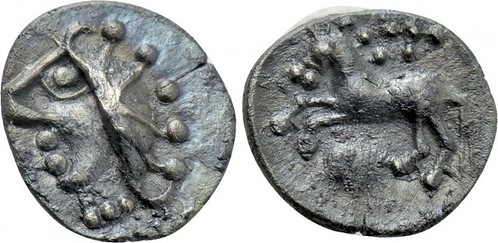
CENTRAL EUROPE. Vindelici. Hemiobol (1st century BC). "Manching 2" type.
Obv: Stylized head left.
Rev: Stylized horse rearing left; pellets above, symbol below.
Cf. Lanz 20-3.
Condition: Extremely fine.
Weight: 0.48 g.
Diameter: 10 mm.
Celtic coins have a special charm. I like this high condition piece. From the March 2019 Numismatik Naumann GmbH auction 75. -Editor
To read the complete lot description, see:
CENTRAL EUROPE. Vindelici. Hemiobol (1st century BC). "Manching 2" type.
(https://emax.bid/en/lot/391598)
Wynn Bros. Montana Counterstamp

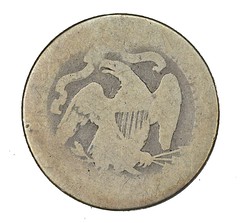
Early Montana Counterstamp "WYNN BROS. / WIBAUX, MONT." (Territory ?)
I don't think I've ever encountered a Montana counterstamp before. From Bob Merchant's latest eBay auctions. -Editor
To read the complete lot description, see:
Early Montana Counterstamp "WYNN BROS. / WIBAUX, MONT." (Territory ?)
(https://www.ebay.com/itm/Early-Montana-Counterstamp-WYNN-BROS-WIBAUX-MONT-Territory/132947408381)
Catalan Local Issue 50 Céntimos

Aigüestosses del Llobregat. Ajuntament. 50 céntimos. (T. 46). Cartón. Nº 137. Raro. MBC+.
From the AUREO & CALICÓ Auction 326 on 14 February 2019. -Editor
To read the complete lot description, see:
Billetes y monedas catalanes / Catalan local issues
(https://emax.bid/en/lot/378311)
French Gymnastics Medal Galvano?


France Sport Gymnastique Gymnatique aux Agrés par Hochard Galvanique 190mm
Great image. My old Pittsburgh friend Rodger Hershey enjoyed collecting coins and medal picturing "Athletes in Action". This one is from the eBay stock of Hedley Betts. It's one-sided and at 190mm, quite large (about 7.5 inches across). I don't read french - is this a galvano? I reached out to Hedley who kindly provided the following background. -Editor
Hedley Betts writes:
It comes from the Archives of the Delande company, which was established in France in the late 19th century. They remained in operation until the 1980s. They produced an extensive range of art and prize medals, as well as trophies, certificates, decorations, uniform pins, etc.
They had contracts with governments around the world mostly to produce decorations.
This Galvano was likely the model from which they created the dies to make medals. They offered medals in various sizes and finishes. Customers could select from a small range of standard reverse designs, some of which could be customized through the use of "insert dies."
They issued many catalogs and brochures to promote their products. Some were general and extensive, while others were more specialized, such as for sports medals or those related to music. (I have a fair selection in my personal library).
To read the complete lot description, see:
France Sport Gymnastique Gymnatique aux Agrés par Hochard Galvanique 190mm
(https://www.ebay.com/itm/163523303853)

STACK'S BOWERS 2019 BALTIMORE EXONUMIA SELECTIONS
Here's a selection of items that caught my eye in the Spring 2019 Baltimore U.S. Coins & Exonumia sale by Stack's Bowers -Editor
Lot 63: MacNeil Hopi Prayer for Rain Medal
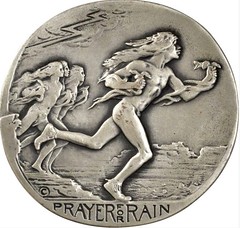
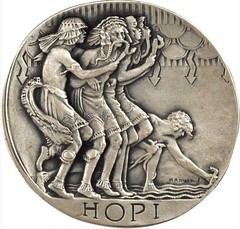
Undated (1931) Hopi Prayer for Rain. Fine Silver. 74 mm x 70 mm, oval. 205.5 grams. By Hermon MacNeil. Alexander-SOM 3. Edge B. Mint State.
Beautiful antique silver surfaces with a fine grain sandblast texture to the finish. One of the more popular Society of Medalists issues, this type was designed by Hermon MacNeil, known to coin collectors for his Standing Liberty quarter. From a mintage of just 25 silver impressions, and rare, as such. The original box and cards are included.
Provenance: From the Collection of Samuel Morse Felton, 1926-2015.
A great medal from one of the nation's top sculptors. -Editor
To read the complete lot description, see:
Undated (1931) Hopi Prayer for Rain. Fine Silver. 74 mm x 70 mm, oval. 205.5 grams. By Hermon MacNeil. Alexander-SOM 3. Edge B. Mint State.
(https://auctions.stacksbowers.com/lots/view/3-GO7ZP)
Lot 127: Manship Gary Memorial Medal


1929 (i.e. 1965) Gary Memorial Medal. Gold (14K), 94.5 mm, 583.2 grams, 10.94 oz troy AGW. By Paul Manship. Murtha-247. Mint State.
Edge marked MEDALLIC ART CO. N.Y. 14K. Obverse portrays left facing portrait of Elbert Henry Gary, founding chairman of United States Steel Corporation. Reverse shows two winged victories lowering a laurel wreath onto the head of a bare-chested blacksmith at his forge, representing the award's recipient, in this case THOMAS F. PATTON, whose name and 1965 date of awarding is engraved below.
The Gary Memorial Medal is the American Iron and Steel Institute's highest award, instituted in 1929 and awarded almost yearly ever since. Thomas F. Patton, then Chairman and President of Republic Steel Corporation, one of America's Big Three steel manufacturers, received this award on May 27, 1965 for "Outstanding achievements in guiding the affairs of American Iron and Steel Institute better to serve its industry and the country, [his] industrial leadership during periods of adversity and crisis, the important role [he] played in the organization and successful administration of [his] company and for [his] devotion to the interests of the iron and steel industry throughout [his] career."
This gargantuan, rich yellow gold award medal is housed in its original fitted clamshell case and is the distinctive work of famous 20th century sculptor Paul Manship, whose prolific sculpture graces museum collections, building facades and public spaces around the world. His most famous sculpture, the 1934 gilded Prometheus that overlooks the skating rink at Rockefeller Center in New York City, is enjoyed by the tens of millions of visitors who visit New York City each year.
His medallic work is also prolific, and collected by dedicated aficionados of his oeuvre ; he modeled a variety of portrait medals but also created works for industry, such as this Gary Award Medal, the 1934 Carnegie Corporation Medal and the 1930 Southern Railway Systems Centennial Medal, among others. His most widely distributed medals are the 1930 Dionysus for the Society of Medalists and the 1960 John F. Kennedy Inaugural Medal.
In general, though, the medallic works of Paul Manship were produced in very limited editions, and even medals like the Gary, now awarded for 90 years, are very rare in the marketplace. Many are permanently locked up in corporate collections and recipient's families, and some were undoubtedly melted down during the 1980 and 2011 run ups in the price of gold with little regard for their numismatic or artistic value. Only 2 offerings of a Gary Award Medal in the last 2 decades were found at Invaluable.com, leaving the current offering as a very rare opportunity to acquire a superb work by one of the most famous 20th century American sculptors in the most noble medal possible.
Appropriately described as "Gargantuan", this massive piece is substantially larger than even a Congressional Gold Medal. The medals of corporate America are an interesting topic worthy of a catalog all their own. -Editor
To read the complete lot description, see:
1929 (i.e. 1965) Gary Memorial Medal. Gold (14K), 94.5 mm, 583.2 grams, 10.94 oz troy AGW. By Paul Manship. Murtha-247. Mint State.
(https://auctions.stacksbowers.com/lots/view/3-GO8HP)
Lot 146: Bartholdi Franco-American Union Medal
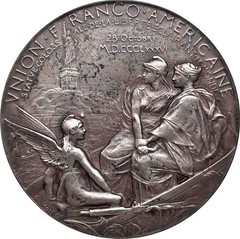

"1886" Franco-American Union Auguste Bartholdi Medal. Silvered Bronze. 68 mm. By Oscar Roty. MS-62 (NGC).
Obv: Liberty, France, and winged Genius admire the Statue of Liberty enlightening the world, legends above. Rev: Olive branch supports Federal and French shields and a medal depicting Auguste Bartholdi, legends throughout. Edge: (cornucopia) BRONZE. A pleasing antique silver example with swirls of deeper flint gray scattered about. Boldly rendered devices and uncommonly smooth surfaces for the assigned grade are sure to result in strong bids for this handsome example.
A great medal and souvenir of American independence. The plaque at the bottom of the reverse is blank - were these meant to be engraved? -Editor
To read the complete lot description, see:
"1886" Franco-American Union Auguste Bartholdi Medal. Silvered Bronze. 68 mm. By Oscar Roty. MS-62 (NGC).
(https://auctions.stacksbowers.com/lots/view/3-GO6YG)
Lot 215: Colored Infantry Sutler Token
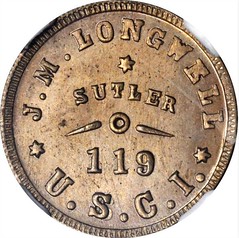

United States. 119th United States Colored Infantry. J.M. Longwell. Schenkman US-119-CN (OH-Not Listed). Rarity-10. Copper-Nickel. 19 mm. MS-64 (NGC).
Unlisted in copper-nickel in the first edition of Schenkman, but would have been Schenkman-R1OCN. Copper-nickel Civil War tokens with Fuld die 1047 (an 1864 Indian Head) are exceedingly rare; a few duplicates have been reported. A major opportunity for both the Sutler and Civil War token collector.
Provenance: From the Q. David Bowers Collection. Earlier from Kreisberg-Schulman's sale of March 1965, lot 1494; our sale of the John J. Ford, Jr. Collection, Part XXIII, August 2013 ANA, lot 21553. The obverse is plated in the second edition of the Schenkman reference on sutler tokens. Lot tag and collector envelopes with attribution and provenance notes included.
A great rarity and historically important. -Editor
To read the complete lot description, see:
United States. 119th United States Colored Infantry. J.M. Longwell. Schenkman US-119-CN (OH-Not Listed). Rarity-10. Copper-Nickel. 19 mm...
(https://auctions.stacksbowers.com/lots/view/3-GO8JS)
Lot 223: Claflin Five Cents Encased Postage Stamp

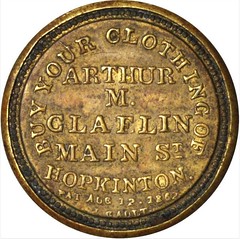
1862 Arthur M. Claflin. Five Cents. HB-91, EP-71, S-61. Extremely Fine.
Case: Both sides exhibit a mottling of antique gold and brassy-copper patina, the reverse also with a few splashes of light rose. A bit of ancient surface build up is noted for the back, although it has little effect on either the quality or eye appeal. Mica: Complete with only minor scratches and an out-of-the-way subsurface lamination at the lower right. Stamp: Well centered, if a tad tight to the top, with a generally smooth appearance and richly original color. An endearing and highly significant example from one of the rarest issuers in the encased postage series.
This encasement advertises the clothing store of Arthur M. Claflin, which was established in his hometown of Hopkinton, Massachusetts prior to the Civil War. All of the denominations currently known -- one, three, five, ten and twelve cents -- were not recorded until 1939. In their 1989 encased postage stamp reference, Michael Hodder and Q. David Bowers estimated that only 15 Claflin encasements of all denominations were known, and we doubt that more recent discoveries have swelled that total to any great degree. The authors knew of just two or three five-cent examples, a total that confirms this as the rarest denomination from this issuer after only the three cents. This is one of our most significant encased postage stamp offerings of all time, a find for the advanced collector that is worthy of the strongest bids.
Provenance: From the Wealth of the South Collection.
Another great Civil War era rarity. Claflin is one of the rarest merchant issuers. I was never able to acquire one of these in my time as an encased postage stamp collector. -Editor
To read the complete lot description, see:
1862 Arthur M. Claflin. Five Cents. HB-91, EP-71, S-61. Extremely Fine.
(https://auctions.stacksbowers.com/lots/view/3-GO8FC)
Lot 271: Blodgett's Georgia Minstrels Counterstamp
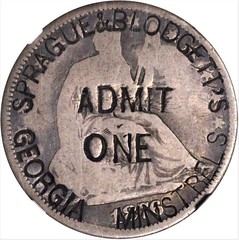
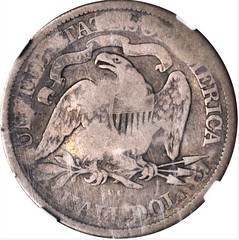
Missouri. SPRAGUE & BLODGETT'S GEORGIA MINSTRELS ADMIT ONE on an 1876-CC Liberty Seated half dollar. Brunk S-776, Rulau Mo-Un 7. VG-10 (NGC).
Counterstamp around and at center of the host coin's obverse. Even lilac-gray surfaces display wear. In fact, the host coin is quite pleasing for the assigned grade and helps to define the counterstamp. This seems to have been an admission ticket worth the face value of the coin.
Provenance: From the Q. David Bowers Collection. Earlier from our sale of the John J. Ford, Jr. Collection, Part XXIII, August 2013, lot 21880. Lot tag and collector envelope with attribution notation included.
With the word "blackface" returning to the news in recent days, this offering is timely. A number of minstrel troupes employed counterstamped coins to advertise their shows. The mintmark of the overstruck coin is interesting as well. -Editor
To read the complete lot description, see:
Missouri. SPRAGUE & BLODGETT'S GEORGIA MINSTRELS ADMIT ONE on an 1876-CC Liberty Seated half dollar. Brunk S-776, Rulau Mo-Un 7. VG-10 (..
(https://auctions.stacksbowers.com/lots/view/3-GO6YY)
Lot 333: Theatre at New York Token
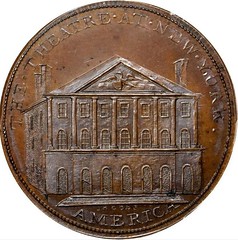
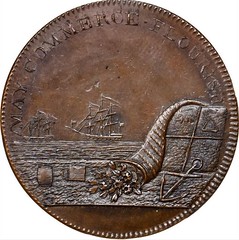
Undated (ca. 1798) Theatre at New York Token. W-9080, Breen-1055. Rarity-6. Proof-64+ BN (PCGS).
These famous tokens were engraved by B. Jacobs and struck at Skidmore's Mint in London. They were struck in copper with a diameter of 34 millimeters. The obverse depicts the architect Brunel's conception of the famed Park Theatre in New York. Said theatre was the largest in New York, situated off Ann Street and Beekman, with the entrance on what became known as "Theatre alley." Large enough to seat 2,372 people, the theatre wrestled with financing and city building codes that hobbled its success. Finally opening after three years of construction delays in January of 1798, this was the largest theatre in Manhattan for a few decades. These tokens were struck to commemorate the opening of the theatre and promote its fame. All shows featured live actors in nightly performances. Only a handful of these tokens are known, with perhaps a dozen remaining in total.
Writing about this type when a different specimen was offered in our March 2012 Baltimore Auction, Q. David Bowers stated:
"For many years this has been one of my favorites of the British conder tokens. The subject is strictly American and the diameter is penny (not halfpenny) size, making it quite impressive. Skidmore issued a number of various tokens for the numismatic trade, all of which are elusive today. The listing of the Theatre at New York in the Guide Book of United States Coins has widened its appeal immensely. Only occasionally does an example appear in the market, and even more widely spaced are offerings of a coin of this [virtually] Gem quality."
Provenance: From the Greenway Collection. Earlier from our (Stack's) June Sale of 1973, lot 855; our (Stack's) Laird U. Park Collection sale, May 1976, lot 76; our (Stack's) Greater New York Numismatic Convention Sale, May 1985, lot 42. Lot tags and Stack's paper envelope included.
Crudely executed, this is nonetheless an important piece of American theater history. -Editor
To read the complete lot description, see:
Undated (ca. 1798) Theatre at New York Token. W-9080, Breen-1055. Rarity-6. Proof-64+ BN (PCGS).
(https://auctions.stacksbowers.com/lots/view/3-GO8WX)

1855 WASS, MOLITOR &CO. $50 PRIVATE GOLD
Last week we discussed private gold coins given to the Hungarian national Museum by Samuel Wass of Wass, Molitor & Co. An 1855 Wass, Molitor &Co. $50 gold piece is offered in the Spring 2019 Baltimore Rarities Night sale by Stack's Bowers. The lot description includes extensive historical background by cataloguer Eric Schena which we're republishing here. -Editor
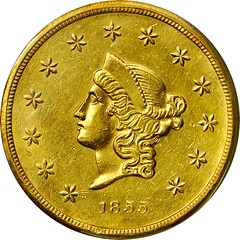
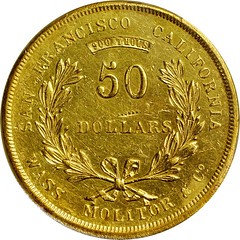
1855 Wass, Molitor & Co. $50. K-9. Rarity-5. AU-55 (PCGS).
The story of Wass, Molitor & Company has its beginnings in the Austro-Hungarian Empire and the 1848-1849 war for Hungarian independence. Born in Hungary, Count Samuel C. Wass and Agoston P. Molitor both studied metallurgy in Germany before returning to their native country to pursue their careers in the Hungarian mining regions. There they remained until the winds of revolution that had been swirling around Europe swept into Hungary culminating in a declaration of independence from the Austro-Hungarian Empire on April 18, 1848. Quickly Poland allied with the Hungarian revolutionaries and war against Austria and the Hapsburg emperor spread throughout the region. The war was finally suppressed in October of 1849, and many of the pro-Hungarian independence revolutionaries were forced into exile, including both Wass and Molitor. Seeing opportunity in North America, many Hungarian expatriates arrived in the United States just as the California Gold Rush was gathering momentum.
Arriving in California from the Old World, these immigrants found a booming economy struggling to cope with explosive growth. Within two years of the discovery of gold, the population in Northern California had quadrupled and continued to grow every day. Unfortunately, the money supply did not grow at the same rate and coinage of any sort was scarce. Transporting freshly mined gold to the mints back East was a long and arduous process and repeated petitions for a branch mint made to Congress back in Washington were met with opposition and would be held up for several years.
While other parts of the country would address such monetary crises with currency, in the West paper was met with almost universal distrust. Indeed this was codified into Article IV section 34 of the 1849 California Constitution which forbade any bank to "make, issue, or put in circulation, any bill, check, ticket, certificate, promissory note, or other paper, or the paper of any bank, to circulate as money." Gold dust proved useful as a stop-gap measure but could be easily adulterated and its purity could not be consistently assured. Many local jewelers and assayers attempted to fill the need for coins but these efforts met with varying degrees of success.
Samuel Wass arrived in San Francisco in October 1850 and set immediately to work in the California gold fields. He produced a detailed geological report of the region which was published in the Alta California on January 13, 1851. Wass prefaced his report with the following explanation as to his reasoning behind his journey to the West:
Gentlemen-As a native of a mining country in Europe I have felt a great deal of interest in all that I have heard and read about this country. My curiosity was highly excited during my sojourn in the States, having received so many accounts of the extraordinary formations and riches of nature in California. I made up my mind to visit the place in the company with two friends…
Wass quickly established a reputation as a highly regarded expert in metallurgy and the latest mining technology from Europe. Sometime in early 1851, Molitor arrived to California and soon joined his fellow expatriate. On October 14, 1851, the pair announced the formation of Wass, Molitor & Co. as an assay office located in San Francisco on Montgomery Street below Bush Street. Success came quickly to the firm and they relocated to the fireproof building formerly occupied by banker and Civil War general Henry M. Naglee, on the corner of Montgomery and Merchant streets. There, they set up an extensive smelting operation and assay laboratory that was widely praised in the local newspapers for its modernity.
At least one newspaper noted that the firm did not endeavor to produce their own coins but rather used whatever was on hand to pay depositors. This may have been the impetus for the assayers to contemplate entering the coining business. In January 1852, Wass, Molitor & Co. announced that they were prepared to begin producing what they referred to as "small coin" in $5 and $10 denominations. The purity levels fell below federal standard, so to compensate, the coins were made slightly heavier. Their coins soon fetched a premium in circulation and were eagerly accepted in trade. The amount of these coins that were struck is not known, but may have been sufficient that no further coining operations were required for the next two years.
In the meantime, Congress finally granted approval for a branch mint to be established in San Francisco which commenced operations in 1854. The difficulty of acquiring the necessary parting acids for refining raw gold meant that it would be some time before the San Francisco Mint would be able to strike enough coins to relieve the region's monetary shortages. After an especially lengthy layoff at the Mint, in March 1855 a group of prominent merchants and bankers petitioned Wass, Molitor & Co. to resume coining operations. The firm responded in the Alta California that it was prepared to do so within a week. Shortly thereafter, Wass, Molitor & Co. resumed striking coins and produced $10, $20, and round $50 gold pieces. These, too, proved to be popular and circulated widely until the San Francisco Mint was able to produce the much-needed federal coins in a more consistent manner.
The design of the $50 piece is more functional than artistic. The bust on the obverse is small, seemingly more befitting a $20 coin. The reverse with its simple wreath surrounding the denomination resembles the contemporary fractional gold pieces. The May 16, 1855, Alta California reported that "Wass, Molitor & Co. have commenced issuing their fifty and twenty dollar pieces, at the rate of $38,000 per day. The coin is above the U.S. standard and is confidently received in trade throughout the State." The round shape also seems to have helped acceptance of the coins since they were easier to handle than their octagonal counterparts from the United States Assay Office of Gold. Despite their brief tenure in circulation at the tail end of the private gold issuing period, the $50 coins were readily absorbed into trade.
By late 1855 Wass, Molitor & Co.'s coins were no longer required. Sometime in late 1855 or early 1856, Wass, Molitor & Co. dissolved and reorganized as Wass, Usznay &Co. Around this time, Wass left the region but eventually returned to continue the assay business with his son. Agoston Molitor left for London in 1856 and did not return to the United States. Premium high grade examples of Wass, Molitor & Co. coins of any denomination are of the utmost rarity and desirability in today's market, and this is particularly true of the $50 denomination. Here is an important survivor from one of the most storied of the California Gold Rush coiners.
To read the complete lot description, see:
1855 Wass, Molitor & Co. $50. K-9. Rarity-5. AU-55 (PCGS).
(https://auctions.stacksbowers.com/lots/view/3-GQ123)
To read the earlier E-Sylum article, see:
HUNGARIAN NATIONAL MUSEUM SAMUEL WASS COINS
(https://www.coinbooks.org/v22/esylum_v22n05a16.html)

1838 PROPOSED NATIONAL CURRENCY NOTE
I came across this item in the February 23, 2019 Early American History Auctions sale. -Editor
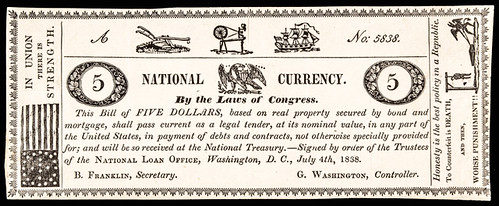
July 4, 1838-Dated Printed Note Illustration, Washington, D.C., "NATIONAL CURRENCY by the Laws of Congress," Five Dollars, "B. FRANKLIN, Secretary - G. WASHINGTON, Controller," Choice Extremely Fine.
Haxby-Not listed. Exceedingly Rare, Printed United States Proposed National Currency Note Illustration, proposed to be issued by the Federal government, the first we have offered. Printed in black on period wove paper titled "NATIONAL CURRENCY" with a decorative border design and wonderful 26-Star American Flag design with logo "IN UNION there is STRENGTH" within the left margin, blank reverse is very clean with light folds. The right side margin vignette with a Hanging Man at the gallows, a casket below reading in part, "To Counterfeit is DEATH and then, WORSE PUNISHMENT" in criticism of our Currency! Its design was included in a pamphlet proposal in 1834 written by Thomas Mendenhall. See: Russ Rulau's "Standard Catalog of United States Tokens, 1700-1900" and Stack's John J. Ford, Jr. Collection Sale. An exceptional, high quality specimen that would prove an important addition to any Banking History and United States Paper Money collection.
The Panic of 1837 was a financial crisis in the United States that touched off a major recession that lasted until the mid-1840s. Profits, prices, and wages went down while unemployment went up. Pessimism abounded during the time. The panic had both domestic and foreign origins. Speculative lending practices in western states, a sharp decline in cotton prices, a collapsing land bubble, international specie flows, and restrictive lending policies in Great Britain were all to blame.
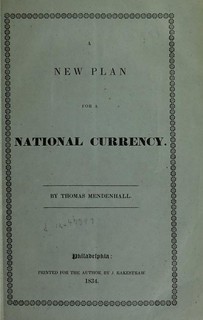 Mendenhall, Thomas. An Entire New Plan for a National Currency: Suited to the Demands of this Great, Improving, Agricultural, Manufacturing &Commercial Republic, with Appropriate Introductory and Concluding Remarks. To Which Is Added, A Plan for a Real National Bank. Philadelphia: J. Rakestraw, 1834, 32 pp., with sample of a $5 issue of national currency tipped in. Disbound but preserving original plain brown wrappers.
Mendenhall, Thomas. An Entire New Plan for a National Currency: Suited to the Demands of this Great, Improving, Agricultural, Manufacturing &Commercial Republic, with Appropriate Introductory and Concluding Remarks. To Which Is Added, A Plan for a Real National Bank. Philadelphia: J. Rakestraw, 1834, 32 pp., with sample of a $5 issue of national currency tipped in. Disbound but preserving original plain brown wrappers.
It is not entirely clear who Thomas Mendenhall was. In this pamphlet he mentions in passing that, during the revolution, he "experienced several times, the misfortune of capture and plunder at sea; and … suffered the horrors of starvation, and other miseries of a British prison ship at New York." He also indicates that he first issued his currency proposal in 1816. In his American Radicalism, 1865-1901, Chester M. Destler identifies this as a pamphlet entitled National Money, or a simple System of Finance; [etc.] (Georgetown, Va., 1816).
Here he elaborates on his earlier proposal and sets out a specific draft statute for creation of a national currency (pp. 17-20). He was well aware of Thomas Law's advocacy of a national currency and calls Law a "respectable writer." But he implies that Law's proposals have lacked specificity. He also sets out specific statutory language (pp. 27-29) for creation of a national bank "founded upon the credit of the Government and its resources," as Andrew Jackson had suggested might be possible in his annual message of 1829.
The national currency would be issued by a National Loan Office and would be a legal tender. The National Loan Office would lend the currency to State Loan Offices at either 4 or 5 percent per annum. The State Loan Offices would in turn lend the currency to individuals at either 5 or 6 percent per annum. The loans to individuals would be secured by land and mortgages on real property, worth double (or at least one third more) than the amount of the loan. Interest on the loans to individuals would be payable annually or semi-annually. As long as the borrower made the interest payments, repayments of principal would be "at the convenience of the borrower." The National Loan Office might also make loans to the states, which they could use to finance internal improvements or to pay down existing debts. Finally, the might authorize the National Loan Office to lend money to the federal government.
Mendenhall anticipates concerns that the national currency might depreciate. He argues that this can't happen because of the security provided for the loans (focusing on the loans to the individual and ignoring his proposals to make loans to the states and to the national government). As he puts it, "the real value of the land is made to pass into the nominal value of the money." With respect to the loans to the national and state government, if such loans "bring a redundant quantity of the currency into circulation, and cause an injurious rise in the prices of specie … , which might erroneously be supposed a depreciation of the currency; it would, in such case, be the duty of the Government and the State Legislatures, to provide ways and means for drawing such redundance out of circulation ..."
He argues that his national currency would be far superior to a currency ostensibly payable in specie. He notes that a specie currency is vulnerable to an export of specie and observes that existing banks cannot really redeem in specie because the amount of specie that they hold in their vaults is generally a very small fraction of their notes outstanding. He believes that the issuance of national currency under his plan will put to rest "the old and delusive dogma, that a specie basis is indispensable in all Banks of Discount and Deposit." Destler concludes that Edward Kellogg (see 1849) drew on Mendenhall for his influential currency plan and for his critique of the Safety Fund System. As will be discussed in connection with Kellogg's works, Kellogg was known as the father of Greenbackism.
Also of note, the sample of national currency that is tipped in is quite charming. It resembles contemporary bank notes but instead of being issued under the names of a bank president and cashier it is issued under the names of G. Washington, Controller, and B. Franklin, Secretary, of the National Loan Office.
On May 10, 1837, banks in New York City suspended specie payments, meaning that they would no longer redeem commercial paper in specie at full face value.
Despite a brief recovery in 1838, the recession persisted for approximately seven years. Banks collapsed, businesses failed, prices declined, and thousands of workers lost their jobs. Unemployment may have been as high as 25% in some locales. The years 1837 to 1844 were, generally speaking, years of deflation in wages and prices.
To read the complete lot description, see:
July 4, 1838 Proposed National Currency Note Illustration
(https://www.earlyamerican.com/Auctions/ClientPages/lots.item.php?auction=2&lot=264&imagesize=G)
Below is a link to a digital copy of the pamphlet on the Newman Numismatic Portal for your reading pleasure. Cover shown above. An example was sold in the Eric P. Newman Collection Part XI (volume 2) lot 15343. -Editor
To read the complete pamphlet, see:
New Plan for a National Currency
(https://nnp.wustl.edu/library/book/523985)
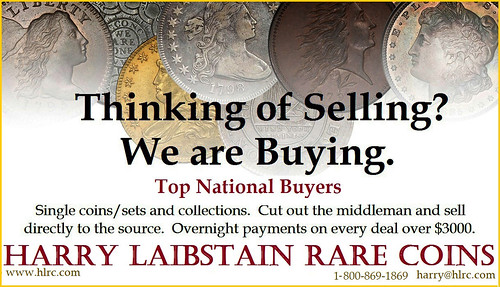
REPLICAS OF WORLD'S LARGEST COIN OFFERED
A 19th century replica of the world's largest coin will be included in an auction of Coins, Tokens and Historical Medals at Dix Noonan Webb in London on February 20-21, 2019. Here's their press release. -Editor

Lot 970
A 19th century replica of the world's largest coin measuring 13.5cm and weighing 900g will be included in an auction of Coins, Tokens and Historical Medals at Dix Noonan Webb, the international coins, medals, banknotes and jewellery specialists. The auction will be held on Wednesday, February 20 and Thursday, February 21, 2019 at 11am at their auction rooms in central Mayfair - 16 Bolton St, London, W1J 8BQ.
Expected to fetch £3,000-4,000, the original was made for Mughal Emperor, Shah Jahan I. A similar specimen is also in the British Museum and both are clearly copies of the same original, a coin which was discovered in Patna in the 18th century and which was last seen in the 1840s. The specimen, worth 200 mohurs, in the British Museum was formerly in the collection of the India Museum in London, which closed in 1879.
Mughal multiple-mohur coins are known to have been struck in denominations up to 1,000 mohurs, probably for presentation purposes; very few are known to exist today, as most were probably melted down at some point.
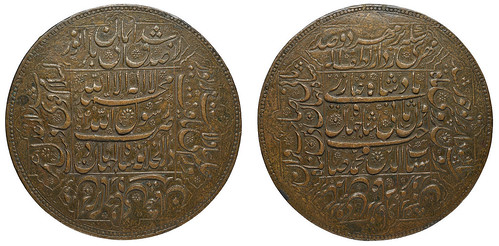
Lot 971
To read the complete lot descriptions, see:
Lot 970: India, MUGHAL, Shah Jahan I, a cast copy, probably 19th century, in plated copper of a gold 200 Mohurs,
(https://www.dnw.co.uk/auctions/catalogue/lot.php?auction_id=507&lot_id=50252)
Lot 971: India, MUGHAL, Shah Jahan I, a cast copy, probably 19th century, in copper of a gold 200 Mohurs,
(https://www.dnw.co.uk/auctions/catalogue/lot.php?auction_id=507&lot_id=50255)
SAGE'S CANDY COIN COUNTERSTAMP
Bill Groom submitted this original article about the popular SAGE'S CANDY COIN counterstamp. Thanks! -Editor
Finally... A Most Likely Attribution!
by Bill Groom
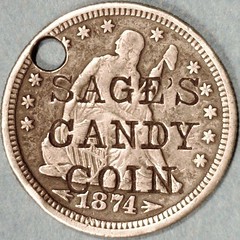
 For decades, the SAGE'S CANDY COIN counterstamps
have puzzled collectors and denied attribution attempts. In his book, Merchant and Privately Countermarked Coins (2003), Dr. Gregory Brunk cited speculation by David Bowers that these stamped coins might have "been given away by a candy company in the same way that prizes are found in boxes of Cracker Jacks."
For decades, the SAGE'S CANDY COIN counterstamps
have puzzled collectors and denied attribution attempts. In his book, Merchant and Privately Countermarked Coins (2003), Dr. Gregory Brunk cited speculation by David Bowers that these stamped coins might have "been given away by a candy company in the same way that prizes are found in boxes of Cracker Jacks."
Dr, Brunk noted that all known host coins bearing Sage's mark were dated 1874 and designated this issue as # S-86. Since 2003, Brunk's recorded more host coins as follows: 23 quarters, 18 half dollars and 6 Trade Dollars. Likely, more specimens have surfaced in the past few years, bringing the total to a possible fifty or more pieces. Note that all known host coins are of "prized" silver content.
Dr. Brunk noted that a search of periodicals for that year, 1874, might lead to the identity and whereabouts of the elusive Mr. Sage. It seems that Dr. Brunk was correct about the periodical source. To the right is a newspaper article that this writer found in the City & Suburban News of Paterson, NJ, dated February 26, 1875 ...
Judging from contemporary newspaper articles, Sage drew impressive crowds and some folks won gold and silver coins in their candy containers. However, Sage's presence in Paterson was short-lived ...
City and Suburban News - March 1, 1875 under "Local Brevities"

City and Suburban News - March 2, 1875 under "Local Brevities"

City and Suburban News - March 3, 1875 under "Local Brevities"

City and Suburban News - March 13, 1875 under "Local Brevities"

It's noteworthy that all of the SAGE'S CANDY COIN counterstamps are hosted upon coins dated 1874. This year coincides with the time, early 1875, during which the mysterious Mr. Sage was active in Paterson. The silver coins would then have been in virtual mint condition, new and shiny. If "Sage" was this huckster's true name, this writer has as yet found no further mention of him elsewhere. There are numerous newspaper articles about similar hucksters operating in many locations like Philadelphia, New York City, Chicago, etc. Possibly, Mr. "Sage" used other names? In addition to "Sage" suggesting a person of wise and prudent judgment, there were some well known contemporaries, Augustus and Russell Sage. Then too, there was the much advertised "Dr. Sage" (a pseudonym) who marketed patent medicine. By and large, these candy lotteries often proved unpopular, and legal action typically ensued. Thus, their tenure in one location was often short yet sweet (pun intended).
Thanks to the research of Bruce Mosher, my counterstamp compadre in New Jersey, it was learned that there were no directory listings for anyone named Sage in the Paterson area; this, between 1873-1876. Interestingly, Bruce learned that there was a confectioner, named Andrew Moser, conveniently located next door to Sage's operation at 216 Main Street. Bruce and I were unable to determine if Moser, at 214 Main Street, had a working or other relationship with Sage; but, may have been his landlord. It's quite possible that it was Moser who supplied Sage with the candy. Moser was then a long-established businessman in Paterson. Surely, even an implied relationship with such a well known citizen such as Moser would have given Sage an air of respectability. Below is given some information on Andrew Moser. Perhaps, a future researcher will be able to connect Moser with the mysterious Mr. Sage?
Part VI. INDUSTRIES Of NEW JERSEY. HUDSON, PASSAIC, AND BERGEN COUNTIES (1883)
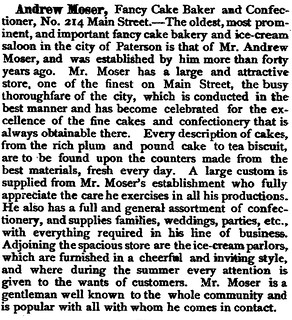
To summarize, Bruce and I agree that these "Sage" counterstamps were among coin prizes that were randomly distributed in packages of candy at 216 Main Street in Paterson, N.J.; this, between February and March of 1875. Mr. Sage was not a local man, and that may not have been his true name. These schemes were commonplace in the mid to late 1800's. In some cases, the lottery hucksters were prosecuted and jailed. In light of this, and in order to avoid running afoul of the law, it makes sense that Mr. Sage "took a powder" and hastily left Paterson; this, inside of three weeks. As no later dated coins with the Sage counterstamp are known, he evidently did not continue his lottery scheme ... at least so, by using the name, Sage! In time, perhaps more light can be shed upon this mystery man.
N.B. - In 2017, I penned an article for NTCA on the "Professor King" tokens, entitled "PUNCHLINES: A Pair of Prestidigitators (Part II)." These may well date to the Civil War era. Like Sage, Professor King (a pseudonym?) operated a lottery scheme in central New York. He "disappeared" pursuant to a legal judgment against him. I'm not proposing that he was also Mr. Sage - just maybe!

GERMAN NOTGELD
Pablo Hoffman passed along this excellent article from Topic magazine about German WWI emergency money. Thanks. Here's an except. See the complete article online for much more. -Editor
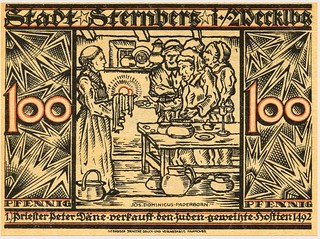 Money is supposed to be abstract. We think of it in terms of what we can buy with it, not what it is physically. Beyond its denomination, and whatever cultural or political figure it happens to be celebrating, we're not supposed to think too much about a bill or coin as an object. But what happens when, in the midst of an economic crisis, artists are given free rein to make their own currency? When paper money becomes not just capital but a consideration of it—a commentary on currency, and a meditation on value?
Money is supposed to be abstract. We think of it in terms of what we can buy with it, not what it is physically. Beyond its denomination, and whatever cultural or political figure it happens to be celebrating, we're not supposed to think too much about a bill or coin as an object. But what happens when, in the midst of an economic crisis, artists are given free rein to make their own currency? When paper money becomes not just capital but a consideration of it—a commentary on currency, and a meditation on value?
In 1914, as Germany entered into World War I, the country suspended its gold standard, temporarily halting the exchange of paper marks for gold to prevent a run on the banks. No longer tethered to gold, the value of Germany's paper currency began to inflate, and scared German citizens began to hoard coinage. As a result, the raw metal worth of a 50 pfennig or 2 mark coin quickly outstripped its face value. (Nickel and copper could be used in the growing military industry.) The German economy ran on these coins: a shirt might cost 5 marks, a pair of shoe soles, 3.75. So the sudden withdrawal of coinage precipitated a severe currency shortage—all within the first few months of the war.
Throughout the country, cities and financial institutions had no choice but to get creative. Enter notgeld ("emergency money"), whose purpose was to paper over the shortages in circulating currency. This new kind of money was never authorized by any central or state bank; it was local governments and banks, as well as employers, that introduced notgeld as a short-term, stopgap measure, a temporary currency with a fixed expiration date that functioned more or less as an IOU. Anything could be recycled into notgeld: tickets, cardboard stock, whatever was lying around. The goal was simply to keep something in circulation that could be used for goods and services so the German economy didn't fall apart.
Germany wasn't the first country to experiment with notgeld; DIY currency has been used in times of crisis throughout history. During the Civil War in the United States, postage stamps encased in brass were accepted as legal tender in the North during a coin shortage that lasted throughout the war. In 1685, when Canada was still part of France, the colony experienced a shortage of French coinage and soldiers threatened mutiny if the government delayed payments to them. In response, finance minister Jacques de Meulles rounded up every deck of playing cards he could find and reissued them as temporary currency. (Germany, too, used the playing-card trick during World War I, creating "spielkarten," currency made from cut-up playing cards stamped with numerals to indicate value.)
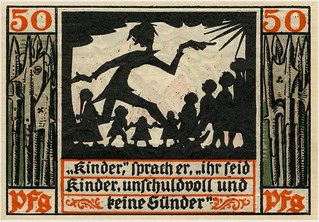 Notgeld was illegal—one can't, after all, print one's own money—but government officials soon realized that it was nevertheless necessary for day-to-day transactions and mostly turned a blind eye. In fact, the less notgeld looked like actual marks, the better. Rare and unusual, the country's provisional currency soon caught the eye of German numismatists and notaphilists. Rare-coin collecting was already a well-established hobby in Germany, so when these strange forms of currency hit the market, collectors almost immediately began to hoard them, and often wrote to issuing authorities requesting examples for their collections. The numismatist Arnold Keller was just 17 when he began collecting notgeld in 1914; three years later, he was printing his own notgeld catalogs for the growing market in ersatz cash.
Notgeld was illegal—one can't, after all, print one's own money—but government officials soon realized that it was nevertheless necessary for day-to-day transactions and mostly turned a blind eye. In fact, the less notgeld looked like actual marks, the better. Rare and unusual, the country's provisional currency soon caught the eye of German numismatists and notaphilists. Rare-coin collecting was already a well-established hobby in Germany, so when these strange forms of currency hit the market, collectors almost immediately began to hoard them, and often wrote to issuing authorities requesting examples for their collections. The numismatist Arnold Keller was just 17 when he began collecting notgeld in 1914; three years later, he was printing his own notgeld catalogs for the growing market in ersatz cash.
To read the complete article, see:
In Case of Emergency, Print Money
(https://www.topic.com/in-case-of-emergency-print-money)

HONG KONG BANKNOTE DESIGNS
An article in Myanmar's The Star interviews the art director responsible for Hong Kong banknote designs. -Editor
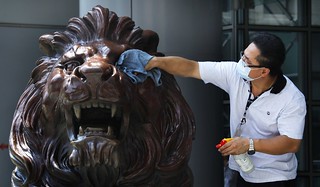 Going cashless may be all the rage in mainland China and places chasing "smart nation" targets, but Tommy Tam Kar Hay is relieved that for now at least, hard cash still rules in Hong Kong.
Going cashless may be all the rage in mainland China and places chasing "smart nation" targets, but Tommy Tam Kar Hay is relieved that for now at least, hard cash still rules in Hong Kong.
There is plenty about the look, feel and history of banknotes to treasure, says the art director for HSBC's Global Publishing Services, which works on the design of banknotes.
Hong Kong's banknote designs tell a lot about the city, its history and what was important at different periods of its existence.
The government is pushing for Hongkongers to go cashless, but cash is still king in the city.
About 70% of Hongkongers have never paid for anything with their mobile phones, a survey by the Hong Kong Productivity Council found last July. The city still lags behind mainland China, where almost 98% of citizens use mobile payment systems.
HSBC is one of three banks which design Hong Kong banknotes, the others being the Bank of China and Standard Chartered Bank.
Tam, who has been with HSBC since 2003 and designed three iterations of banknotes, hopes different payment systems can coexist and hard currency will live on.
To him, banknotes often depict people, places and even animals that are unique or symbolic to a specific place.
The notes issued by HSBC feature a pair of lions named Stephen and Stitt that have guarded the bank's building in Central since 1935.
The pair were stolen by the Japanese during the occupation, presumably to be melted down to make ammunition, she said.
"By a quirk of history, that didn't happen," Swinnerton said.
An American naval officer noticed the lions at a dockyard in Japan and told HSBC when he arrived in Hong Kong, allowing the government to launch a mission to recover the lions.
"When they returned to Hong Kong, the prosperity was also starting to return to the city after the war. So the lions became closely associated with protecting the fortunes of the city," she said.
To read the complete article, see:
It's not a cashless society yet in Hong Kong where banknotes still rule
Read more at https://www.scmp.com/news/hong-kong/hong-kong-economy/article/2185164/money-money-money-its-not-cashless-society-yet-hong#61AhXIj7affm4Uoa.99
(https://www.thestar.com.my/tech/tech-news/2019/02/08/money-money-money--its-not-a-cashless-society-yet-in-hong-kong-where-banknotes-still-rule/)
PAPER BIKINIS SUPPLANTING HELL MONEY?
We've all read about "hell money", offerings burned in Asian societies to honor ancestors. How about "bikini money"? -Editor
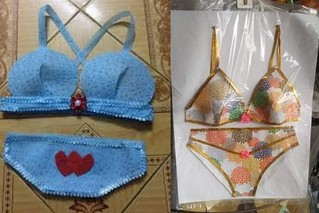 Some new variations of joss paper in Vietnam are getting too risqué for comfort.
Some new variations of joss paper in Vietnam are getting too risqué for comfort.
Burning joss paper during festive occasions is an age-old tradition in Vietnam, where religious residents believe that whatever they burn will reach deceased relatives in the afterlife, providing them with wealth and comfort. The most common items are usually fake money or even house models made of paper.
However, the Ministry of Culture, Sports and Tourism recently issued a directive to provincial and municipal culture departments across Vietnam urging local officials to curb the practice. According to the ministry, a worrying trend has gained popularity over the past years where joss paper vendors start selling items that are inappropriate and not suitable for Vietnamese culture. These include paper bikinis, men and women's underwear, and other types of swimwear.
I reached out to our resident Vietnam expert, Howard A. Daniel. Thanks. -Editor
Howard adds:
I have never seen or heard about them. The article does mention it does not fit into Vietnamese culture. I am thinking that they have to be Chinese-made and something they can make more money on instead of the funeral paper money. I do not know anyone in Viet Nam who would use them.
To read the complete article, see:
Burning Paper Bikinis for Deceased Ancestors Is Vietnam's Hottest New Vogue
(https://saigoneer.com/saigon-culture/15623-burning-paper-bikinis-for-deceased-ancestors-is-vietnam-s-hottest-new-vogue)

LOOSE CHANGE: FEBRUARY 10, 2019
Here are some additional items I came across in the media this week (sometimes with the help of readers) that may be of interest.
Look out, kids - the subject line of yesterday's Coin World digital edition read, "Mint to launch rocket at children." -Editor
Union Soldier Gets Medal of Honor Back
 Thomas Fallon had been in the United States barely two years when he signed up to join the Union's 37th New York Infantry in 1861.
Thomas Fallon had been in the United States barely two years when he signed up to join the Union's 37th New York Infantry in 1861.
The Irishman fought in more than 20 major Civil War battles, waded through the Savannah canal and once captured 29 Confederates, eventually becoming Freehold Borough's only Medal of Honor recipient.
Yet somehow his medal spent the last six decades at Dickinson College in Carlisle, Pennsylvania, under another war veteran's name.
"I know that since 1957 that medal has not honored the man that it's due to honor," said Muriel Smith, a local historian. "So it's about time 100 years later that he be honored for what he did during the Civil War."
To read the complete article, see:
For decades, this Civil War Medal of Honor memorialized the wrong man
(https://www.usatoday.com/story/news/nation/2019/02/08/civil-war-medal-honor-returns-freehold-after-dickinson-college/2818046002/)

The Future of Bitcoin
Gosia Fort passed along this article on a panel discussion on the future of Bitcoin at the University of Pittsburgh. Thanks. -Editor
 "Bitcoin is like a new language, except it's a new currency. It could become the new global currency, but it will only become that if that's what people want. There's no way to force bitcoin against the will of the people. If people around the world find it more convenient to use Bitcoin than domestic currencies, then it will become the universal, global currency of humankind," Wilmer said.
"Bitcoin is like a new language, except it's a new currency. It could become the new global currency, but it will only become that if that's what people want. There's no way to force bitcoin against the will of the people. If people around the world find it more convenient to use Bitcoin than domestic currencies, then it will become the universal, global currency of humankind," Wilmer said.
To read the complete article, see:
Point of View: Three Pitt Scholars Discuss the Future of Bitcoin
(https://www.pittwire.pitt.edu/news/point-view-three-pitt-scholars-discuss-future-bitcoin)
Cryptocurrency Exchange Owner Dies With Password
Ron Guth writes:
Here's a cautionary tale about why it is important to keep your password safe but to share it when it matters.
The unexpected death of the owner of Canada's largest cryptocurrency exchange has left £145 million of cryptocurrency locked in a digital wallet to which he reportedly had the only password.
Indeed. You can't take it with you, but you can sure make it hard for anyone else to get it. -Editor
To read the complete article, see:
Bitcoin: Millions of dollars of cryptocurrency 'lost' after man dies with only password
(https://news.yahoo.com/millions-dollars-cryptocurrency-apos-lost-114732535.html)
FEATURED WEB PAGE: CHARLETON PRESS
This week's Featured Web Page is a very extensive Wikipedia entry for Canada's Charleton Press. It includes an interesting history of the firm's relationship with Whitman Publishing.
The Charlton Press, is a book publishing company, which produces pricing guides as well as other books on related topics, including; collectables, (coins, banknotes, medals, sports cards, clocks, dolls), and porcelain figures. The company's first title was Catalogue of Canadian Coins, Tokens & Fractional Currency, published in 1952 and contained all coins used as circulating tender in Canada from 1858 until present.
https://en.wikipedia.org/wiki/Charlton_Press


